Sourdough Artisan Bread
This post may contain affiliate links. Please read our disclosure policy.Sourdough artisan bread is what sourdough dreams are made of. Crispy on the outside and soft on the inside. It toasts up to make delicious sandwiches and stays good for days. This Sourdough Artisan Bread is a labor of love, that you will want to make over and over again. It doesn’t require too much hands on time – just a lot of rise time.
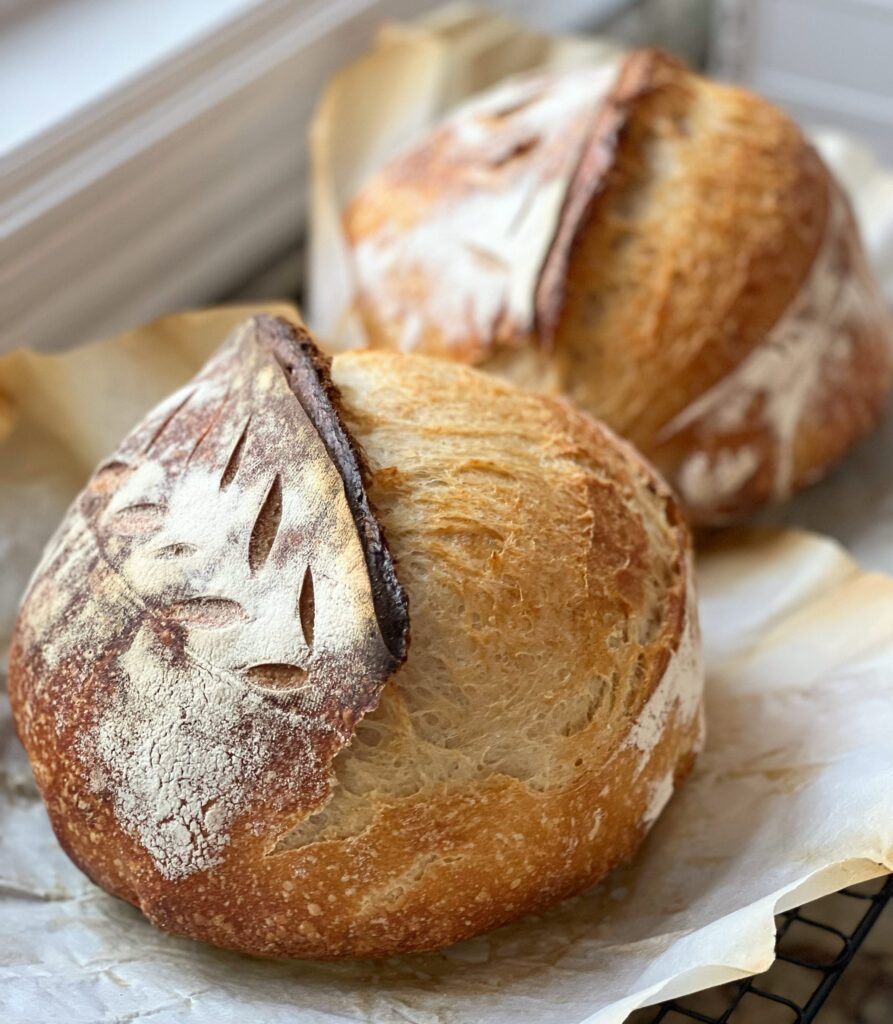
This is an advanced sourdough recipe. If you are looking for an easier, beginner version, check out this beginner sourdough.
Want more in-depth Sourdough instruction?
Check out my online sourdough classes or take a class in person.
My Sourdough Story
Over a decade ago, before I knew about the health benefits of sourdough or the 2020 sourdough craze, I first started making sourdough bread. At the time I had twin babies and a toddler. I was exhausted all the time and had absolutely no time for myself. I would lie on the floor of my twins room, waiting for them to fall asleep for nap time and research sourdough bread. It was an outlet for me that was much needed at the time and it brought me a lot of peace. As I’ve refined my skills over the years, I’ve grown more in love with sourdough and spent years practicing and improving. This Sourdough Artisan Bread recipe was the first recipe I taught myself, tweaked and eventually mastered. I find myself returning to it again and again because it is just so good. I hope you love it too.
Take a look at the improvement: One of my most recent loaves of sourdough artisan bread on the left and my very first ever loaf of sourdough artisan bread on the right.


Sourdough Artisan Bread Ingredients
Making a loaf of bread completely from three ingredients: flour, water and salt feels good and tastes incredible. These are the ingredients you’ll need for the recipe:
- Active Sourdough Starter: Make your own, get some from a friend, get a free dehydrated one in my master class or purchase one.
- Bread Flour: Good quality bread flour with 12-12.5% protein content, I purchase mine from our local mill but King Arthur makes a good one too.
- Whole Wheat Flour: This recipe uses a small amount of whole wheat flour. Use a hard whole wheat flour.
- Water: Use a room temperature (78 degree F) water.
- Salt: Salt helps temper yeast and enhances flavor. Don’t leave it out!
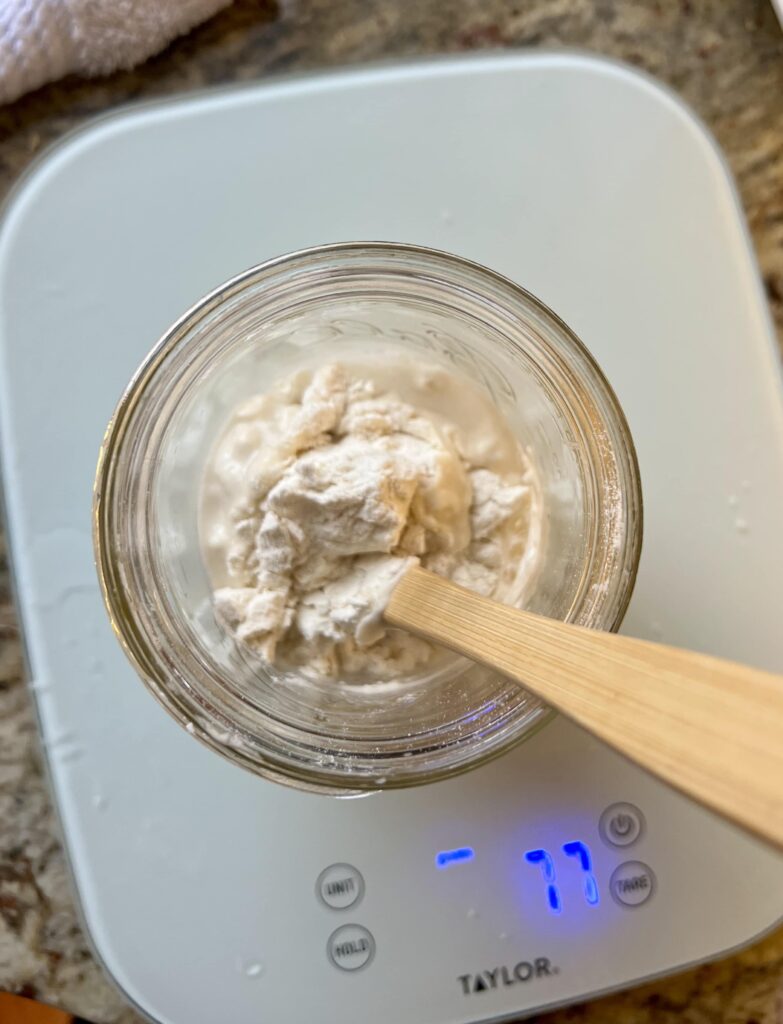
Helpful Tools for Sourdough Artisan Bread
I’m a big proponent of using what you have and not buying more unless you really want to. Most of the items below are very helpful in making a beautiful loaf of sourdough artisan bread. Make do with what you can and if you find yourself baking sourdough bread a lot, it’s worth looking into purchasing some of these items. I have a more comprehensive list here and my Amazon Storefront has up to date links of the items I use.
- Digital Scale: Artisan bakers scale all of their recipes based on ratios and the percentage of the total flour in the recipe. This is called a Baker’s percentage. Percentages are much easier to work with using the metric system and basing recipes on 1000 grams (or 1 kg) of flour. Recipes can be easily scaled down or up based on these percentages. Do yourself a favor and grab a digital scale.
- Mixing Bowl: You will need a large, wide bowl for mixing the bread.
- Thermometer: I have baked too many loaves of sourdough that didn’t turn out just because I didn’t pay attention to the temperature. Sourdough loves the temperatures around 75-80 degrees. Invest in a bread thermometer so you will be able to calculate rise times and water temperature.
- Bench Knife: I love my bench knife. I use it to separate and shape dough all the time. This one is similar to the one I have.
- Proofing Baskets or Bowls: In my early days of sourdough baking I used mixing bowls. I found small bowls with a bit of a wider opening worked best. Now I’ve invested in some bread proofing baskets which I love. If you are planning to make sourdough often, they are worth it. You can try different shapes of bread proofing baskets. I tend to stick with round shapes because my dutch oven is round. Mine look like these.
- Parchment Paper: Using parchment paper makes it easier to transfer the bread to the oven. I turn my bread out onto a piece of parchment paper, score it and easily move it into a dutch oven to bake. I love this parchment paper that I buy at Costco. You can also try silicone, re-usable baking mats.
- Dutch Oven: For the best sourdough bread, this is a must have in my opinion.To get the dark, crispy crust and beautiful oven spring it is known for, sourdough artisan bread needs to have two things: plenty of steam in an enclosed place AND high heat that doesn’t fluctuate. A simple dutch oven will solve this issue for a home-baker. Make sure you purchase the dutch oven you want for the shape of your bread. If you want oval shaped loaves, you should look for an oval shaped dutch oven and round loaves should be baked in a round one. Look for a dutch oven that is rated to 500 degrees F and is 5-7 quarts in size.
- Bread Proofer or Warming Mat: This is definitely a splurge item but I am loving having a bread proofer or dough mat in my kitchen. It can be difficult to keep the temperature in check with fluctuation in the seasons and temperatures of kitchens. A bread proofer helps maintain the desired temperature for dough, starters and levain as temperatures around you change. A warming mat is also a great, less expensive option for keeping a starter or dough warm. There are definitely work-arounds without needing to purchasing a proofer: keeping an oven light on and sticking your dough in the oven to rise (not turned on). The goal is to find someplace that you can keep the temperature constant. If you bake a lot of sourdough bread, you may want to look into one of these options.
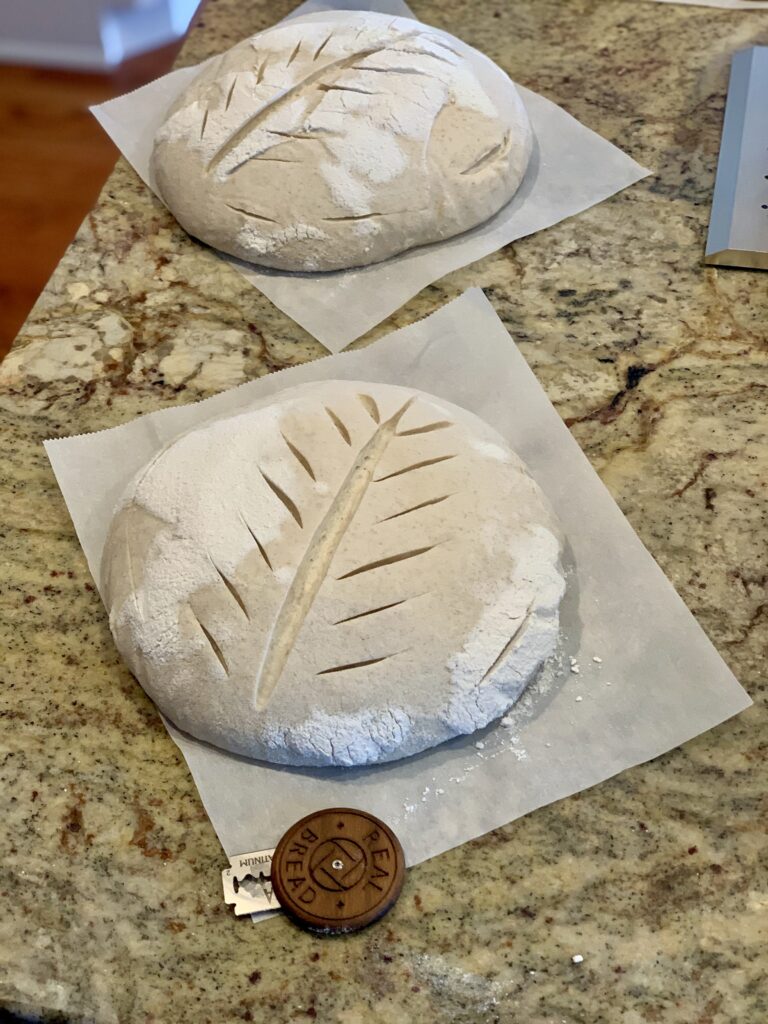
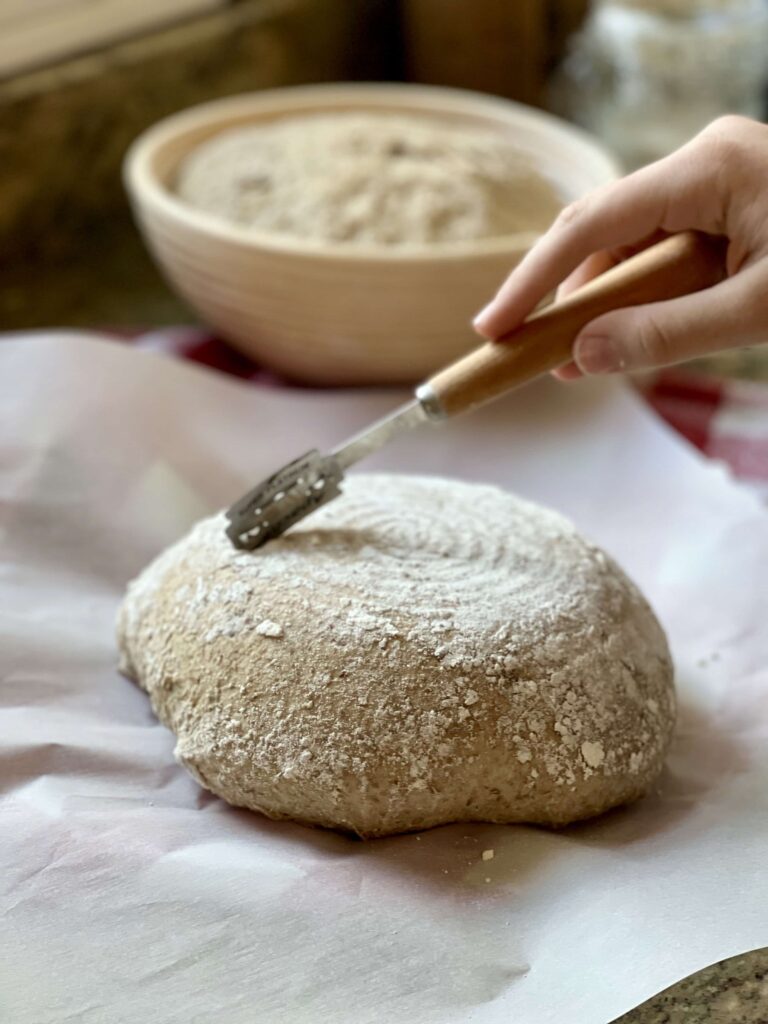

Sample Sourdough Artisan Bread Schedule
Sourdough Artisan Bread is a multi-day process. Even though it takes a couple of days it does not require a lot of hands-on time. Most of it is rising and fermentation time. You can easily work some loaves of bread like this into your schedule over a weekend or when you have a 4-5 hour block of time at home.
Note: This sample schedule assumes a dough temperature of 78-80 degrees F.
| Day 1 | |
| 9:00 PM – 9:00 AM | Make levain. Let sit overnight at 78℉ for 10-12 hours to ferment. |
| Day 2 | |
| 9:00 AM – 9:30 AM | Fermentolyse: Mix together 200 grams ripe levain, 1000 grams flour & 700 grams of the water (hold back 50 grams). Let rest for 30 minutes |
| 9:30 AM – 9:45 AM | Mix the dough: add the reserved water & salt to the dough and mix for 3-5 minutes. Begin Bulk Fermentation |
| 10:00 AM | Stretch and Fold #1 |
| 10:30 AM | Stretch and fold #2 |
| 11:00 AM | Stretch and fold #3 |
| 11:30 AM | Stretch and fold #4 (if needed) |
| 11:30 AM – 1:00 PM | Bulk Fermentation Continued |
| 1:00 PM | Divide/Pre-Shape/Bench Rest |
| 1:30 PM | Shape and place into prepared bannetons/bowls |
| 1:40 PM – 8:00 AM | Cold Fermentation See Recipe Notes for Same-Day Bake Option |
| Day 3 | |
| 8:00 AM | Pre-heat dutch oven to 500 degrees F |
| 9:00 AM | Score and Bake |
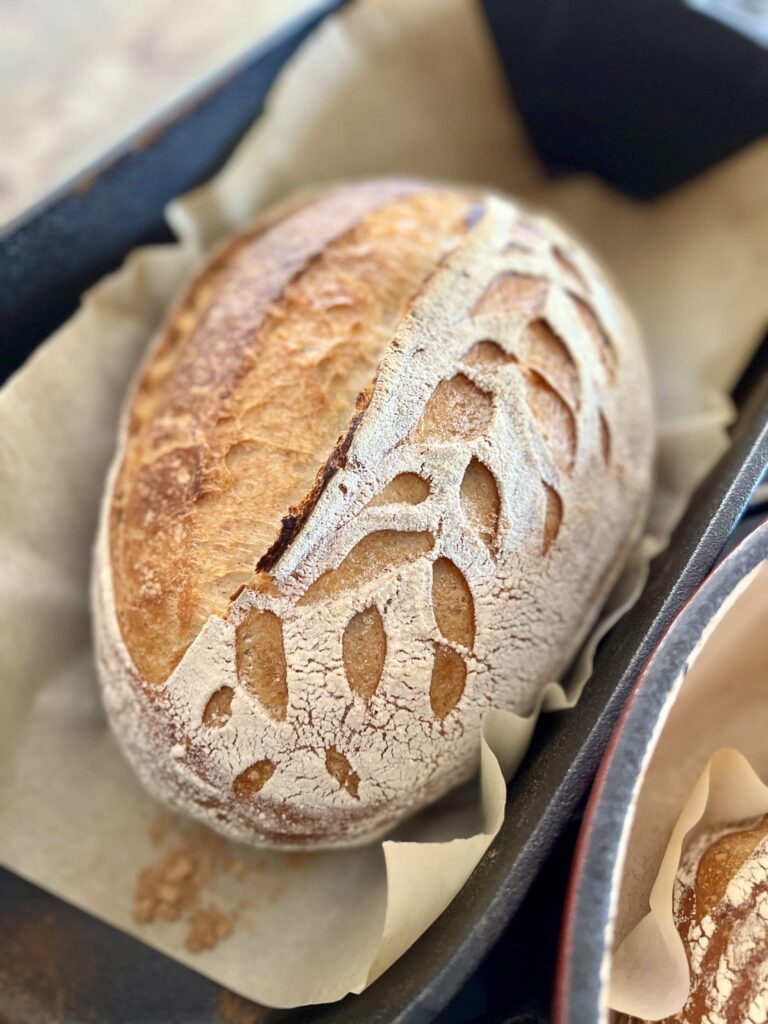

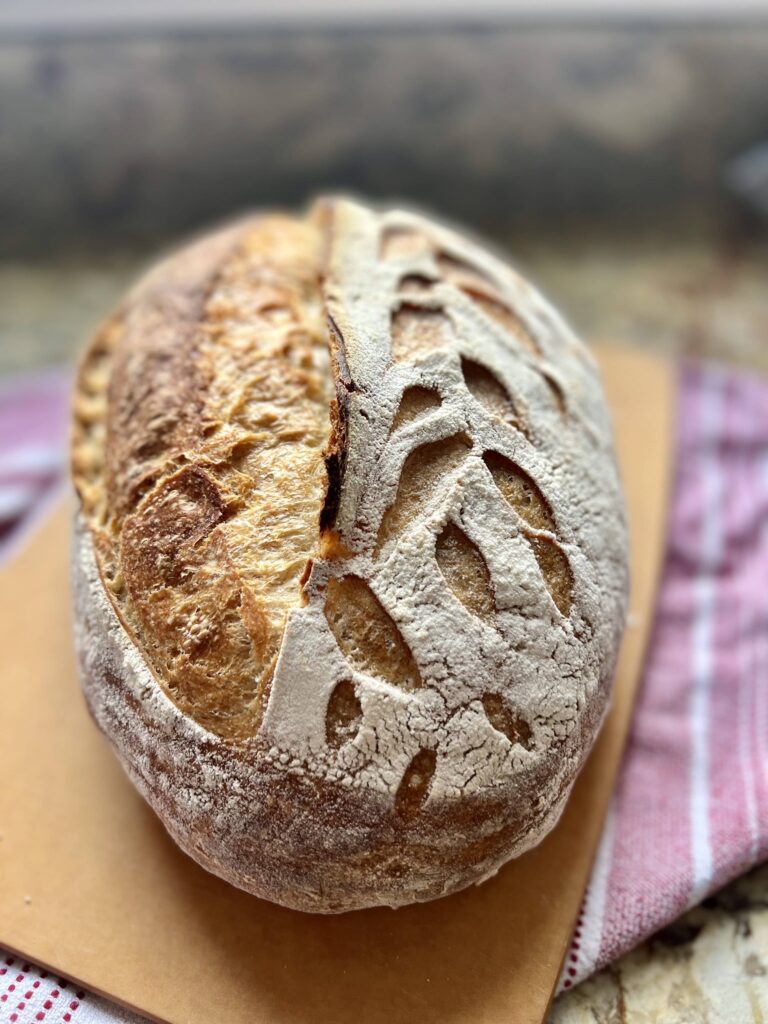
It Starts with a Sourdough Starter
A ripe and active sourdough starter is a key to this recipe. If you are planning to use a starter that has been kept in your refrigerator and is fairly sluggish, add a day to this recipe and feed your starter twice (once at night, once in the morning) before building your levain. If you don’t have a sourdough starter yet, you can make your own, purchase one or get some from a friend who bakes with sourdough. You want to use a starter that is bubbly, active and feed it a few times before mixing your levain.
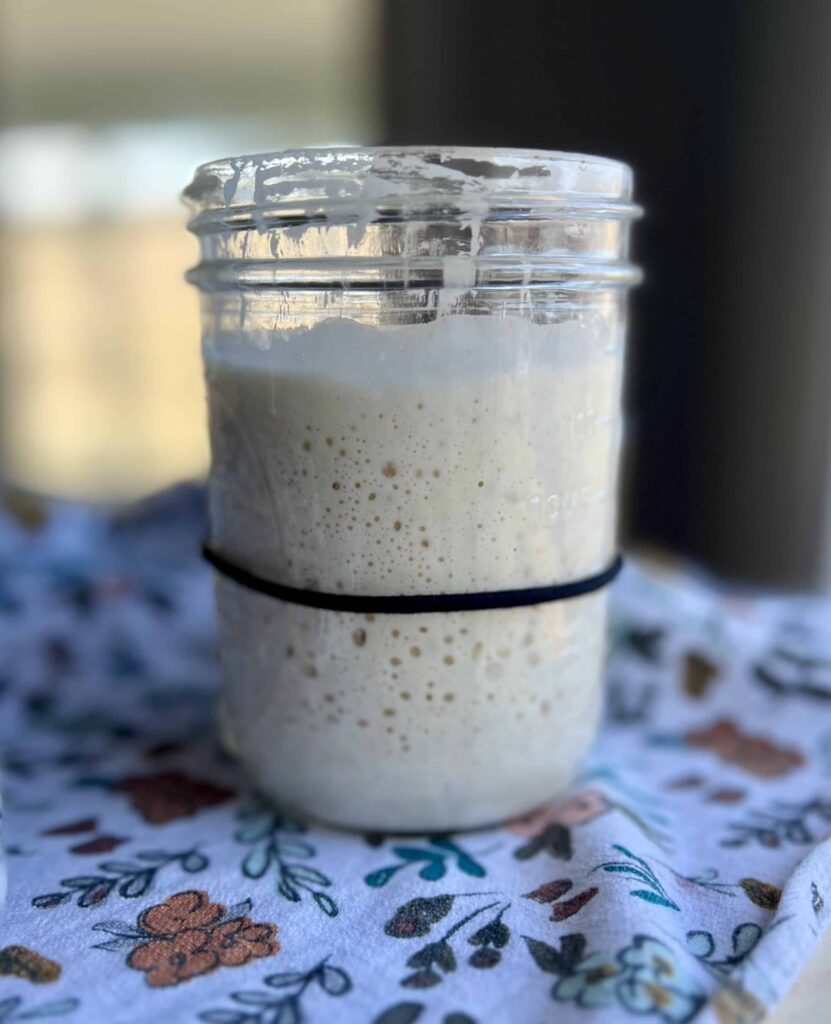
Temperature and Fermentation
Temperature is one of the most important variables in making sourdough bread. It will affect how quickly your starter will rise and fall (or if it will rise and fall at all). Always shoot for 76-80 degrees F for the “room temperature” of your sourdough starter, levain and dough. If your ingredients are cold, add warm water (not going too much above 90 degrees) to help maintain the temperature. Keep in mind that the overall process of preparing and baking with sourdough takes a lot longer than with dough made with commercial yeast (instant/dry active) – as much as two or three times as long. Store your rising levain and dough in a warm 78 degree place. I love my bread proofer for this but an oven or microwave with the light turned on (just don’t turn the actual oven on) works too. The good news is that a lot of this time is fermentation and rise time, not hands-on time! Read more about temperature and sourdough here.
A word of caution: I have baked too many loaves of sourdough that didn’t turn out just because I didn’t pay attention to the temperature. If you are having problems with your sourdough bread not rising, check the temperature!
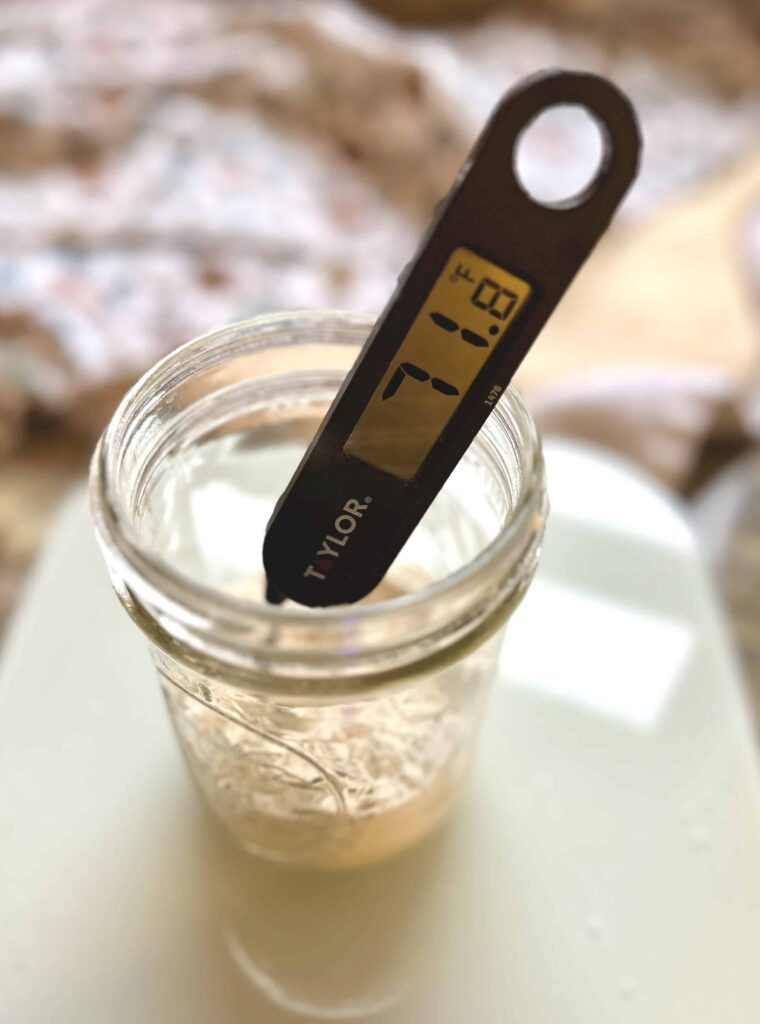
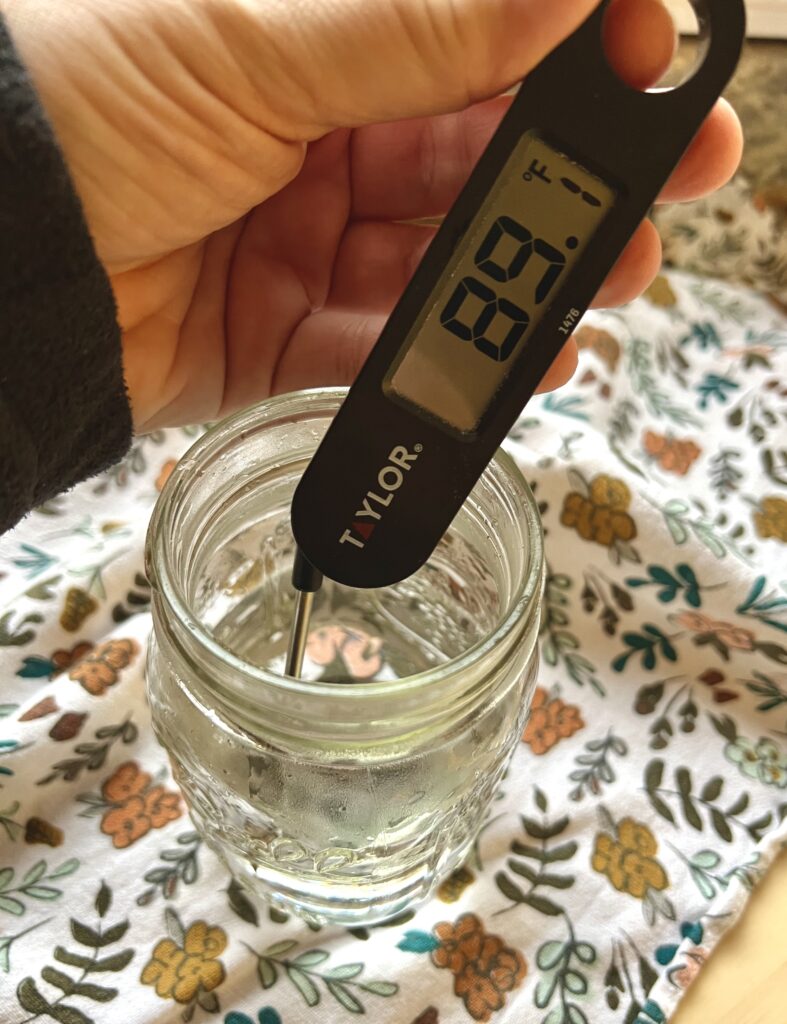
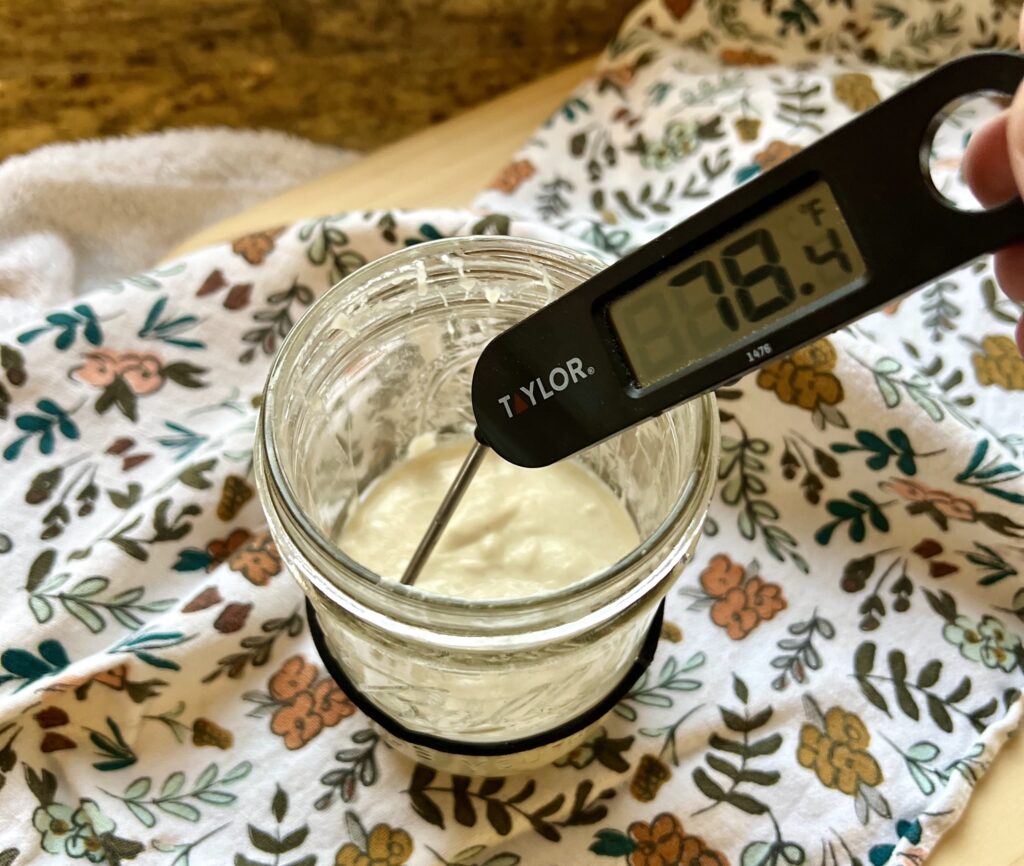
Mixing the Levain
You can read more about why I use the levain process here.
1:10:10 Levain (ready in 10-12 hours/overnight if kept at 78 degrees F): Before mixing, take the temperature of the sourdough starter and bread flour. If it is colder than the 76-80 degree range, use warm water to mix the levain. If the ingredients are warmer than 76-80 degrees, use cooler water. The goal is for the levain to be in the 76-80 degree temperature range. After mixing, cover loosely and let sit overnight, or about 10-12 hours in a warm place (76-80 degrees F). This is your levain.
- 12 grams of ripe/mature sourdough starter
- 120 grams white bread flour
- 120 grams water
1:1:1 Levain (ready in 3-4 hours/same day): If you forget to mix the levain the night before or prefer to mix the levain the day of mixing the dough, you can mix up this levain which should take about 3-4 hours, assuming 78 degrees F, until it’s ready to be mixed with the dough. Adjust the sample schedule accordingly.
- 85 grams of ripe/mature starter
- 85 grams of warm water
- 85 grams of bread flour

How do I know When the Levain is Ready to Use?
Once the levain is mixed, it will go through a fermentation process over a period of hours. Levain is ready to be used when it is ripe, see the list below:
- Just Mixed Levain– fresh smell, no sourness, little to no rise
- Young Levain– sweet with just a touch of sour notes, beginning of a rise, bubbles scattered
- Ripe Levain– sour undertones, doubled in size, many bubbles, just reached it’s highest point and starting to go back down
- Overripe Levain– bubbly/frothy/watery, collapsing in the jar, sour smelling/vinegary smell
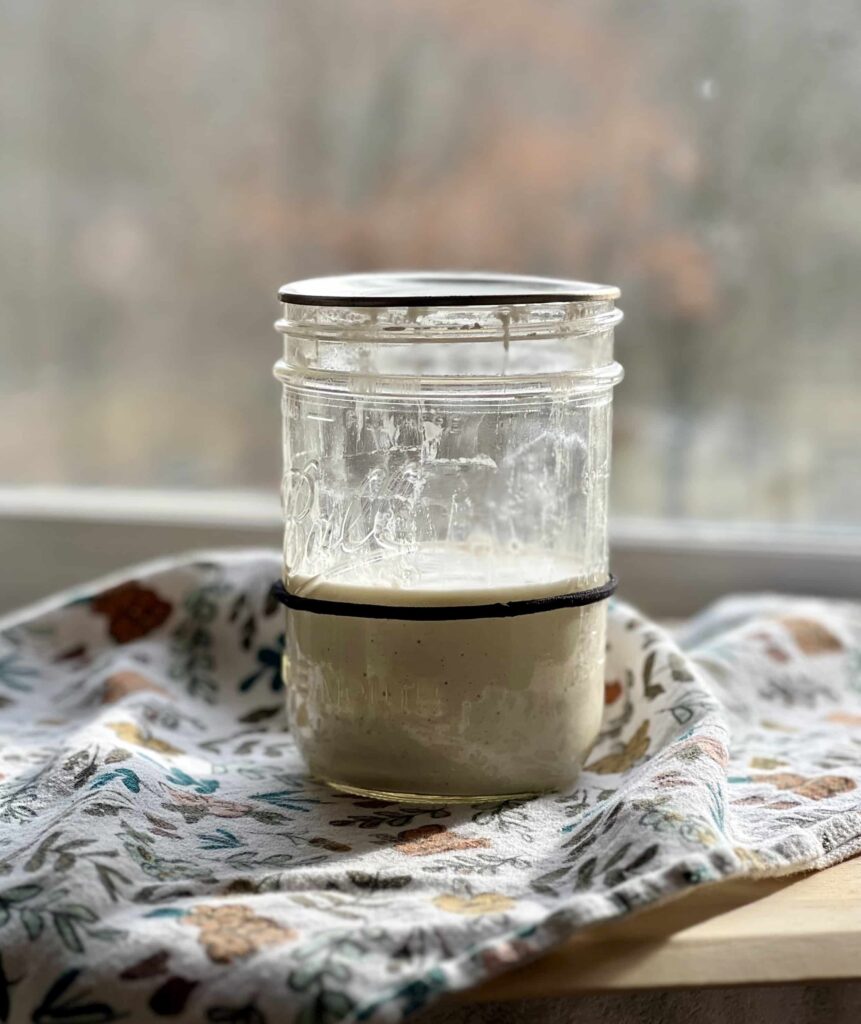
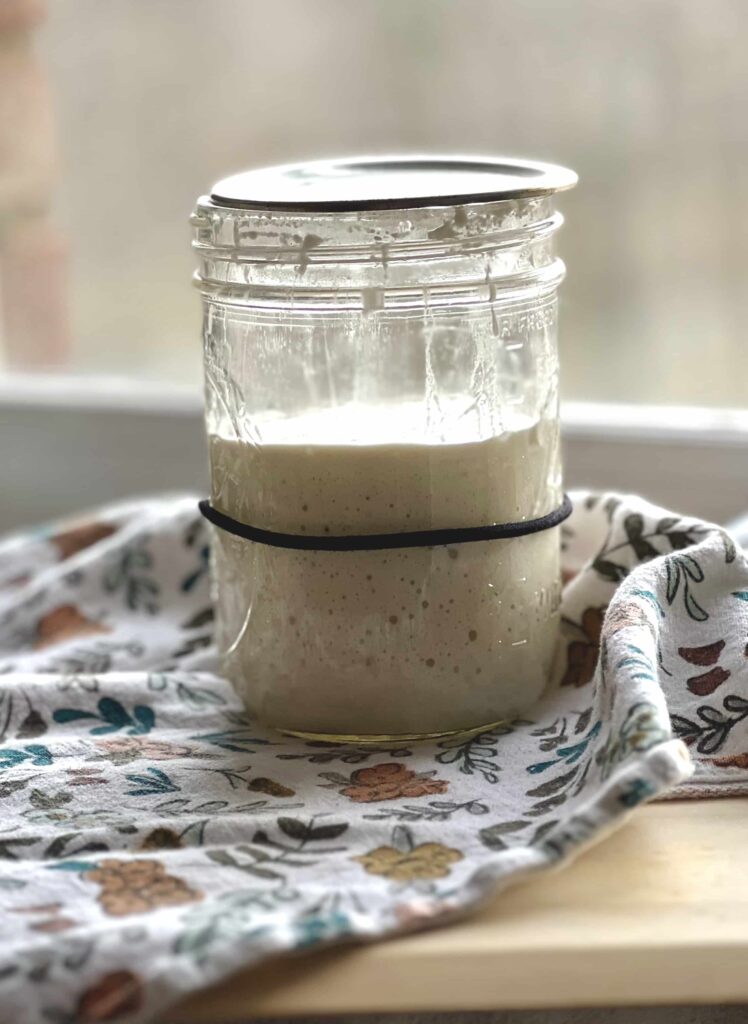
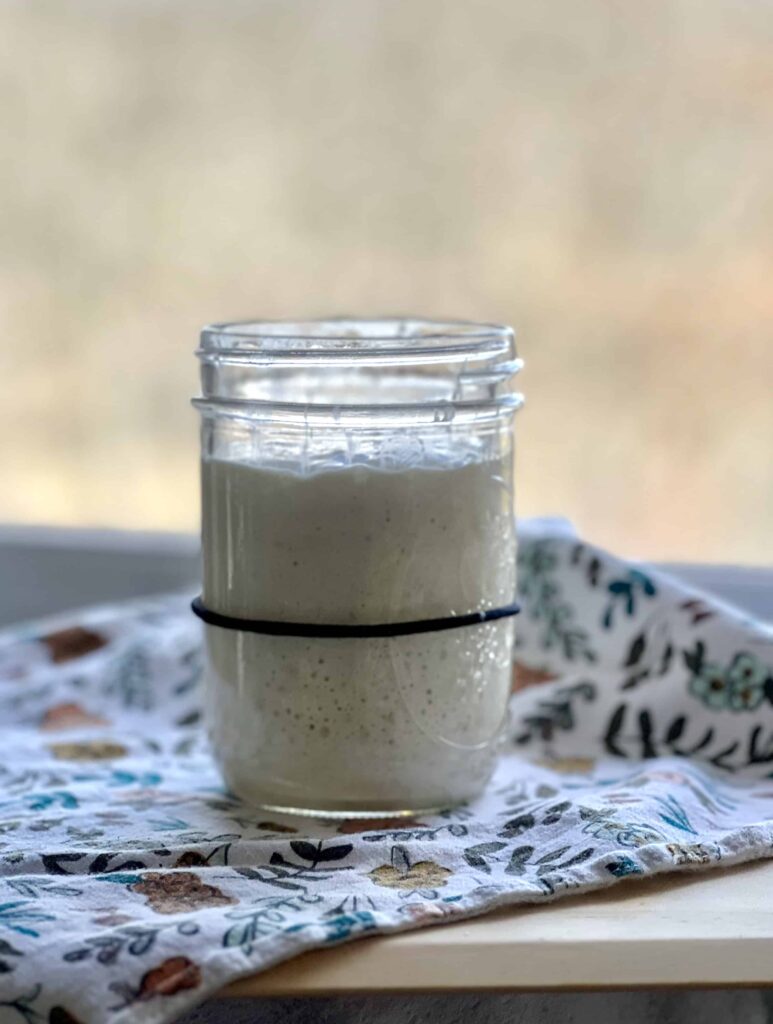
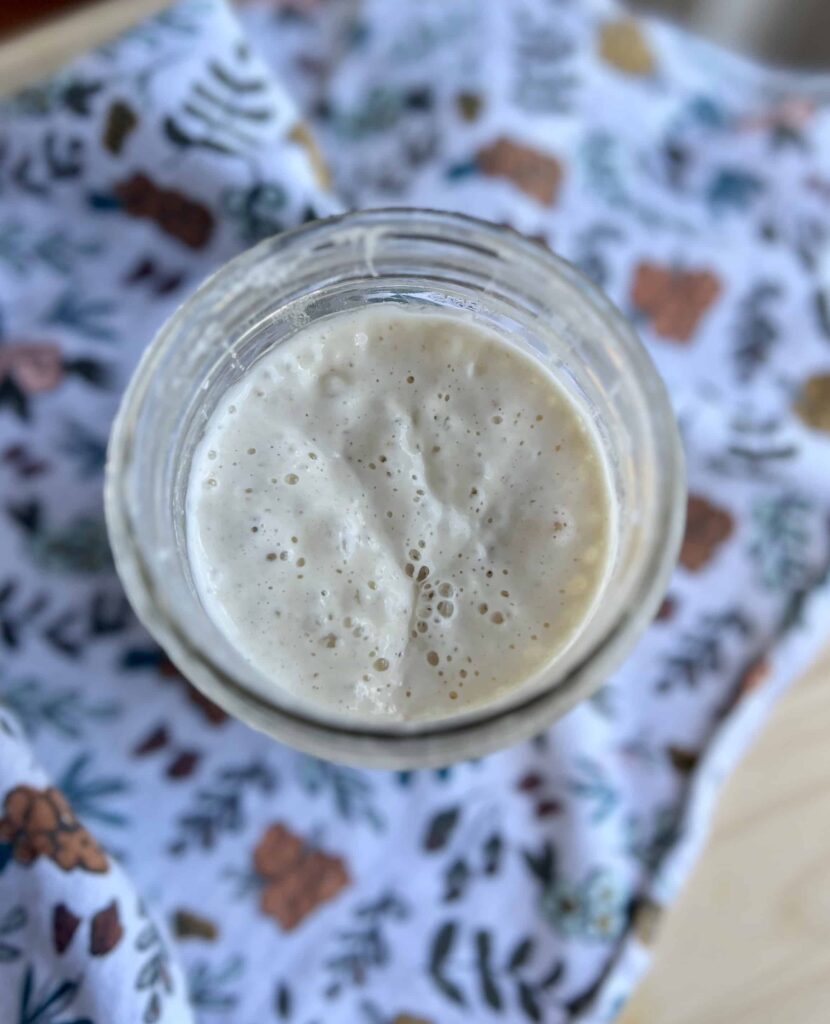
The Fermentolyse Process
This recipe calls for a “fermentolyse” which is a short 30 minute mixing and resting of the flour, water and levain. Hold back 50 grams of water and the salt. Mix the flour, water and ripe levain together. Let the dough rest for 30 minutes and then add the 50 grams of water and salt. Proceed with the stretch and folds in the recipe. Note that fermentation time begins when the levain is added. The total bulk fermentation time for this recipe (INCLUDING stretch and folds) is 4-5 hours. Read more about the autolyse/fermentolyse process here.
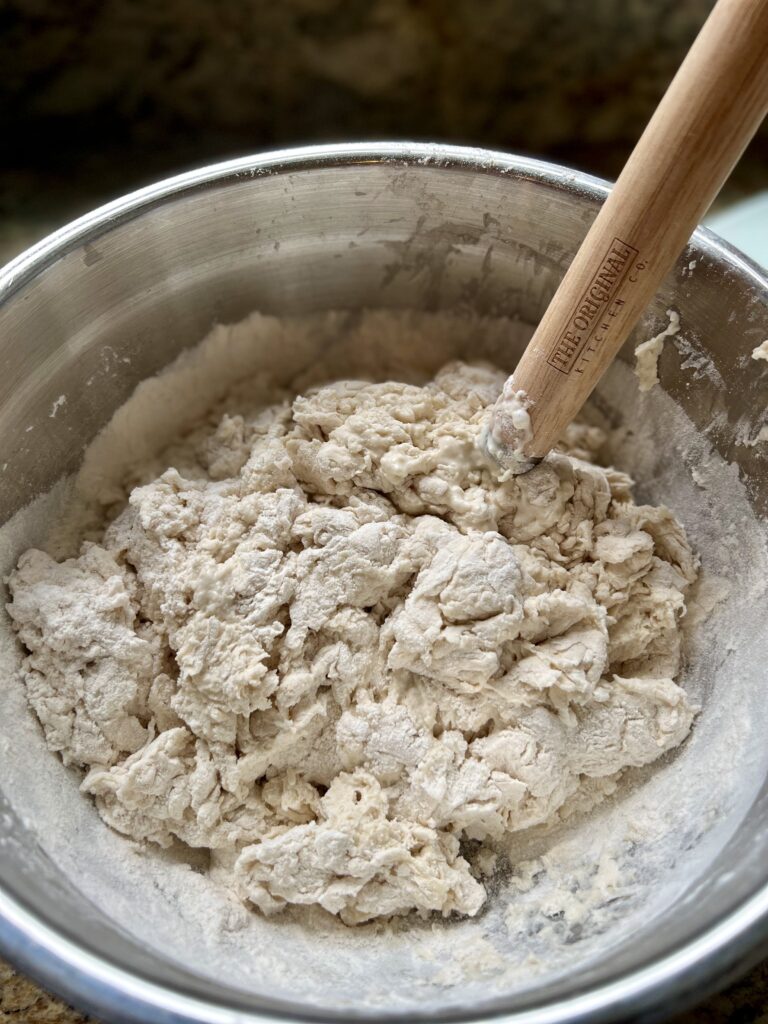
Mixing the Dough
After the 30 minute fermentolyse, notice the dough feels elastic and smooth:
- Add 20 grams of salt and 50 grams of water to the dough.
- Combine by hand: Squeeze the dough between your fingers, pinching chunks of dough to reincorporate it together.
- Wet your hands as needed
- Pick up one side of the dough and fold it over on itself. Continue to work with the dough in the bowl until it is smooth about 3-5 minutes. It will still be a very wet and sticky dough.
- Transfer the dough to a plastic container or a glass bowl if desired.
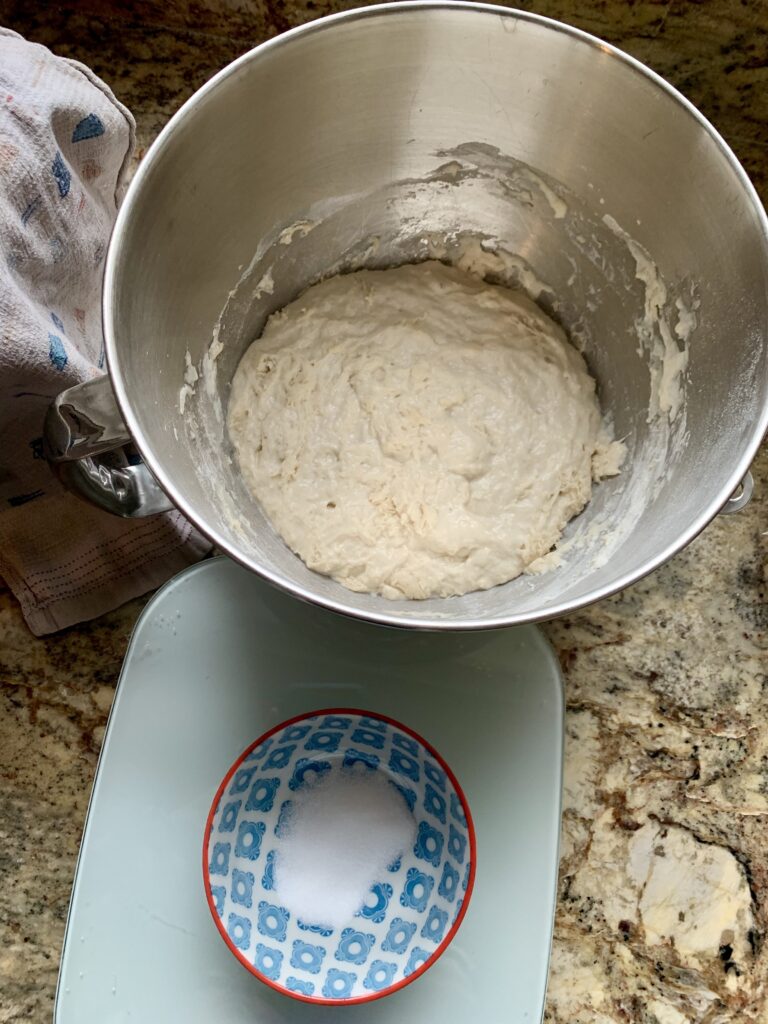
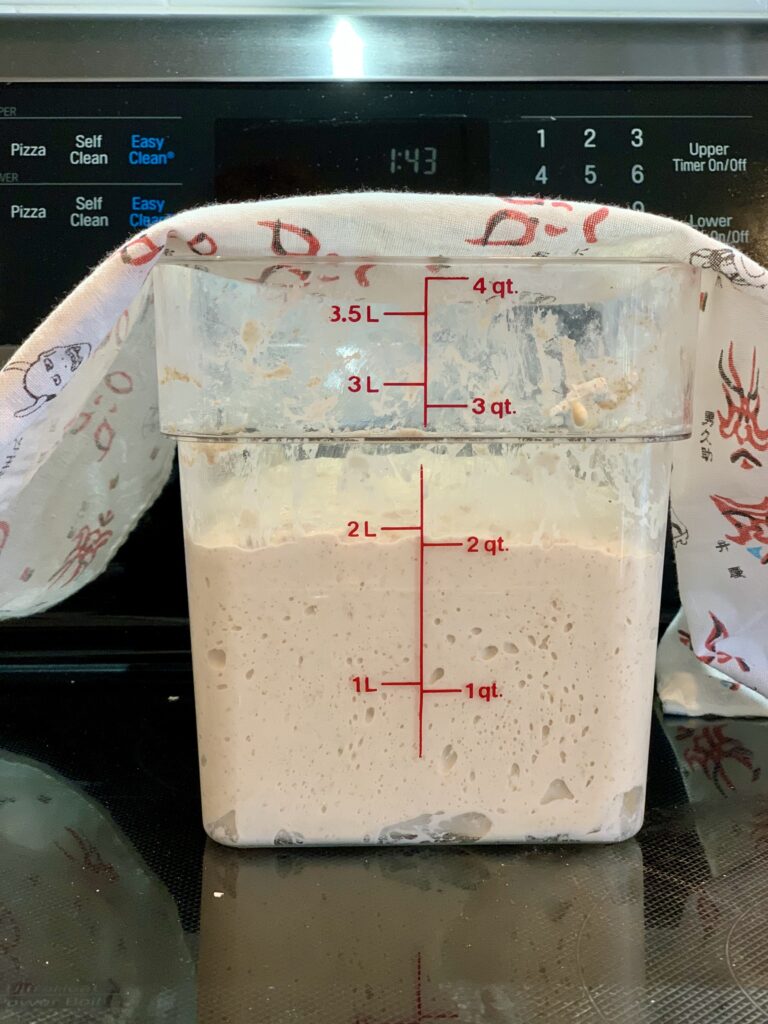
You may have some leftover levain once the dough is mixed. Store it in the refrigerator and use in some of my favorite sourdough discard recipes. My super popular sourdough discard soft white rolls, muffins, and brown butter sourdough cookies. The possibilities are endless!
Bulk Fermentation
The bulk fermentation process takes about 4-5 hours total (assuming dough temperature is 78℉) and begins as soon as the levain is added to the dough. No “traditional” kneading method is used. Instead mix the dough and perform a series of “stretch and folds” throughout the next 2 hours. Time and these folds help strengthen the gluten strands in the dough which are used to trap the CO2 given off by the wild yeast. The longer the gluten strands, the better the rise and overall loaf of bread.


Stretch and Folds
To “stretch and fold,” wet your hand (so it doesn’t stick to the dough). Reach down to the bottom of the bowl of dough and pull the dough up and over the top of the dough. Turn the bowl 1/4 turn and repeat the stretch and fold. Turn another quarter turn and repeat. Perform one more 1/4 turn with stretching and folding the dough. Cover and set aside. Take note of how the dough feels through this process. It will go from feeling a little shaggy to smooth and elastic. I like to set a timer and follow this rough schedule for stretching and folding the dough:
- Stretch and Fold #1: 30 minutes in to bulk fermentation
- Stretch and Fold #2: 60 minutes in to bulk fermentation
- Stretch and Fold #3: 90 minutes in to bulk fermentation
- Stretch and Fold #4: 120 minutes in to bulk fermentation if needed


It’s okay! Just add one in when you remember. The bread will still turn out delicious even if you forget a few stretch and folds.
Signs the Dough is Ready for Shaping
At this point, cover the dough and let it rest for 1 1/2 to 2 more hours. You will know the dough has finished the bulk fermentation process when:
- Dough has risen (not doubled) and puffed up/inflated
- Look for bubbles on the sides and top of the dough, it will probably have a few
- Gently shake the bowl–the dough should jiggle
- The edges of the dough should dome in toward the center of the bowl
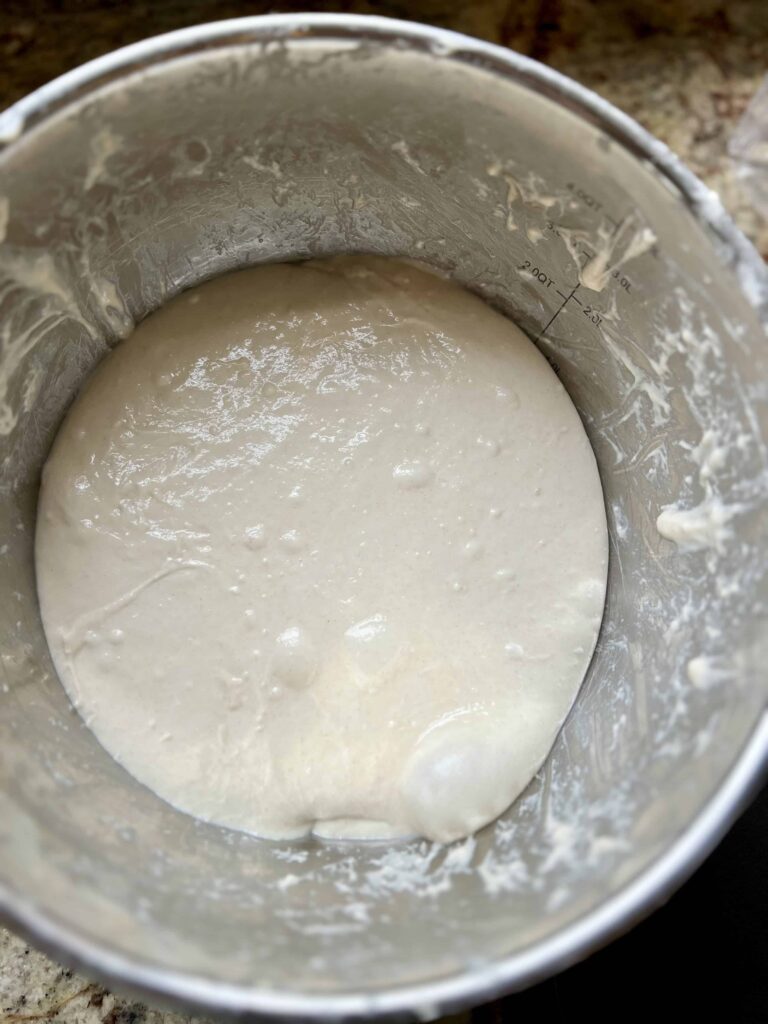
Divide/PreShape/Bench Rest
Divide: Tip the bowl upside down, allowing the dough to fall onto a clean counter surface. Be gentle to avoid degassing the dough as much as possible. Use a bench knife to cut the dough into two equal portions. This is a wet and sticky dough. A bench knife helps make the dough manageable.
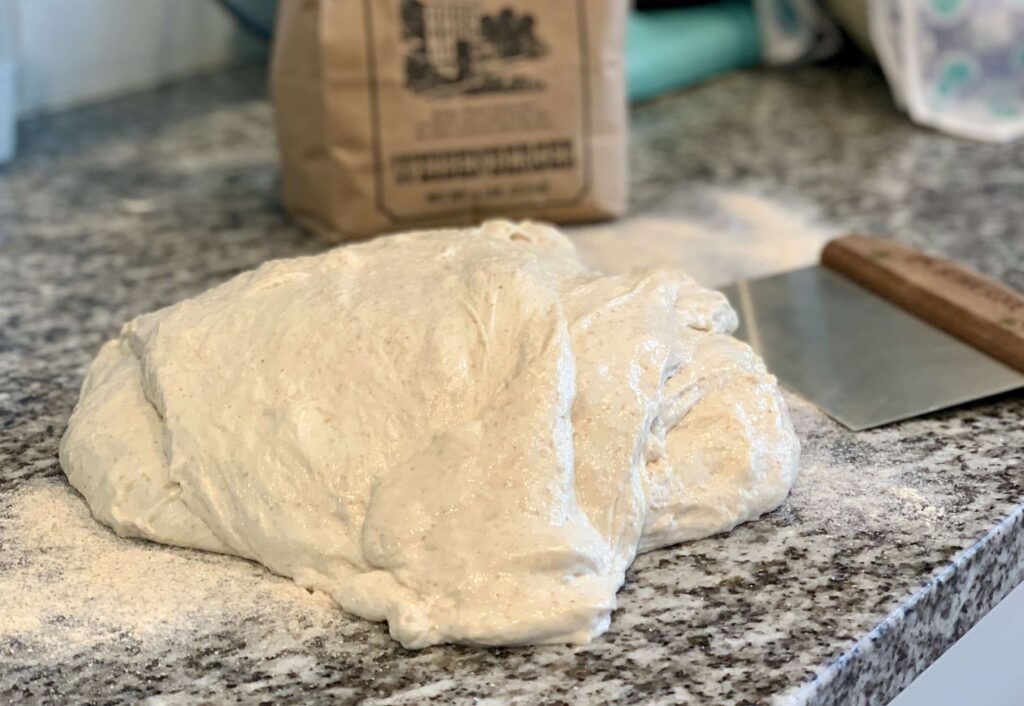
Pre-Shape: Wet your hands and the bench knife if needed and push the bench knife under the dough on one side and your free hand on the other side to tuck the dough under itself. The goal is to introduce some tension into the dough. Repeat this process going around in a circle until you have a ball of dough. Repeat with the second loaf.
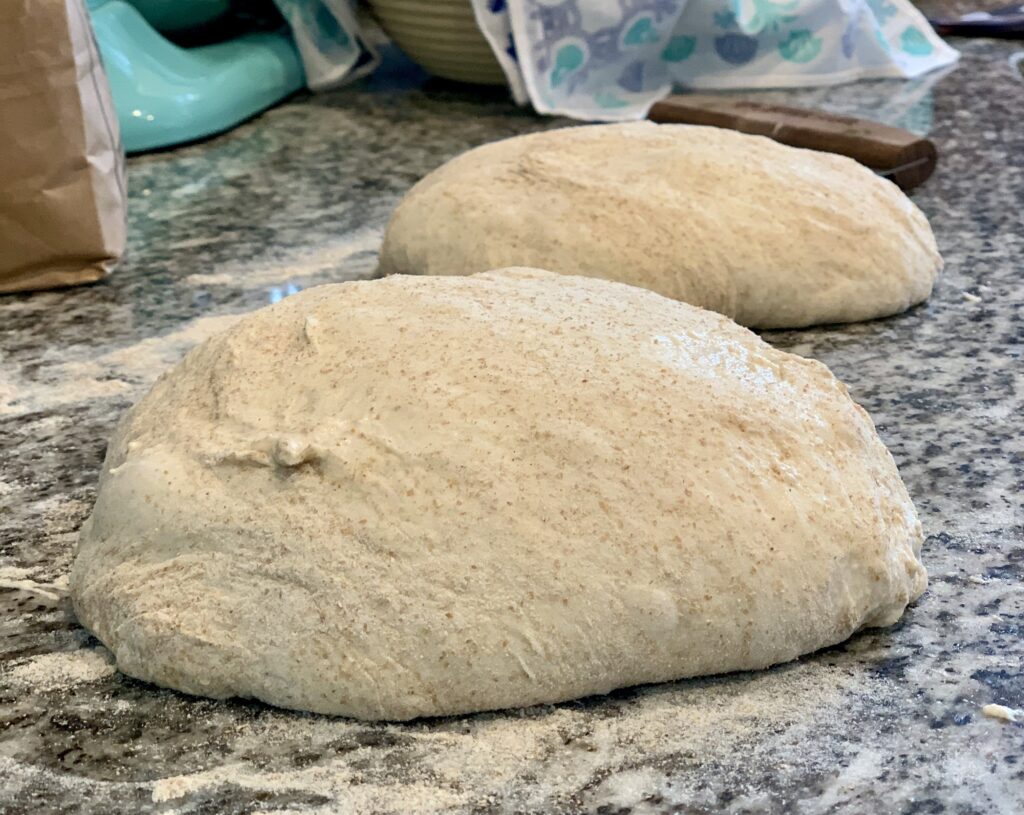
Bench Rest: Let the dough rest uncovered for about 30 minutes at room temperature. The dough will flatten a bit (like a pancake) during this period of time. This allows the gluten in the dough to relax and prepares the dough to be shaped.

Shaping Sourdough Artisan Bread
Prepare the bowls: Prepare two bannetons or small bowls. Place a kitchen towel or hair net in a bowl. Liberally flour with each bowl.
Shaping: After the dough has rested for about 30 minutes it is time to shape the bread into a round. Sprinkle flour on top of the dough (I use a fine mesh strainer). Using the bench knife, lift the dough up off the counter and flip it over onto the countertop, floured side down. This ensures that the flour is staying mainly on the outside of the dough.
Starting at the side of the dough closest to you, pull it towards you and fold it up and place it on the center. Repeat the process by pulling the right side of the dough out, stretching it, and then back to the center. Then pull the left side of the dough out to stretch and then to the center. Pull the opposite side of the dough up and towards you and tuck it over like a package. Use your hands and bench knife if needed to drag the dough into a circle. Place the dough into the floured basket. Repeat with the second ball of dough. I always liked seeing this process before doing it myself, so check out this video to see the shaping process.
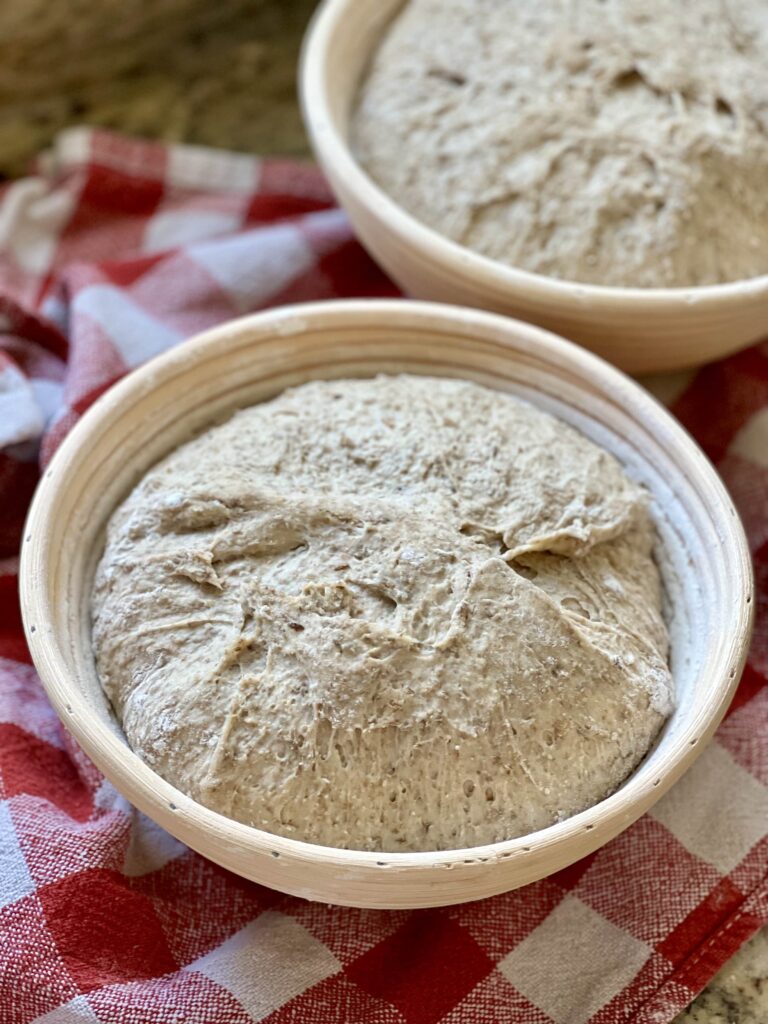
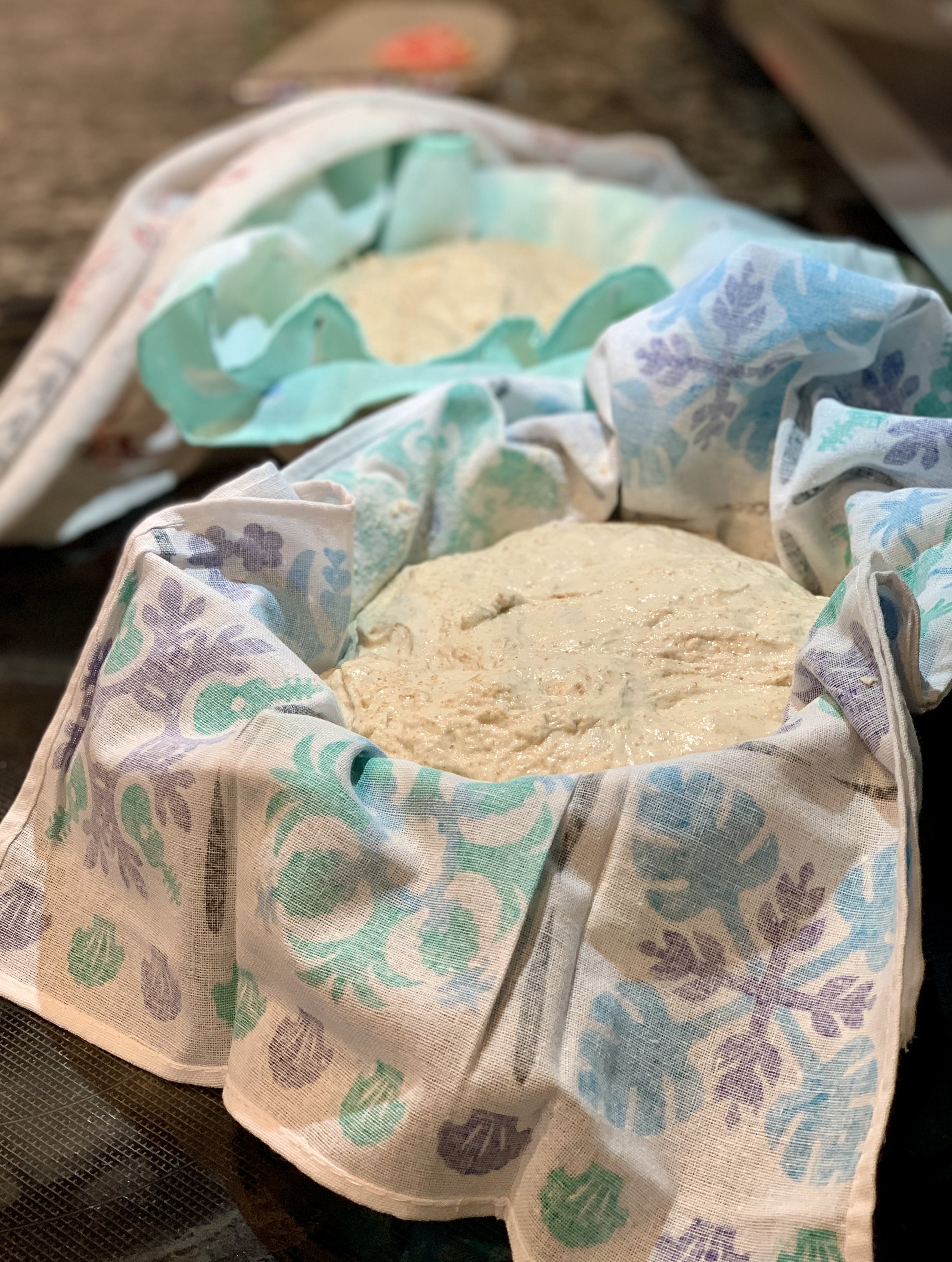
Cold Fermentation
Cover the dough with the tea towel/hair net/plastic wrap and refrigerate overnight or up to 18-20 hours. If you want to bake the same day, you can let the dough rise for about 3-4 hours and proceed with baking. However, it will be much more difficult to score the dough and it may not be quite as flavorful as dough that has undergone a long cold fermentation.
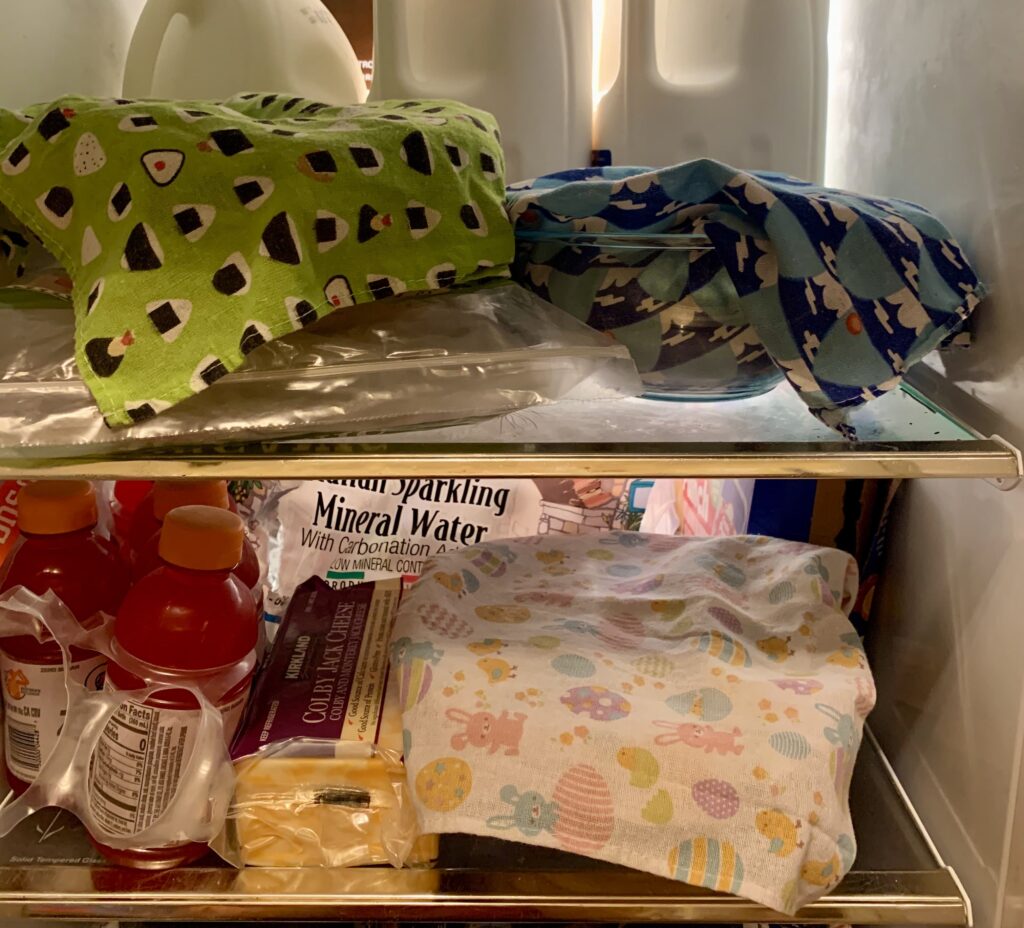
Baking Sourdough Artisan Bread
Pre-heat the Oven: Put your dutch oven (top and all) into the oven and preheat to 500 degrees. Allow the dutch oven to heat for about 30 minutes to an hour at 500 degrees before baking your first loaf. You are working with very high temperatures and you don’t want to burn yourself, so make sure you have some good hot pads. Once preheated for 30 minutes, pull your first loaf out of the refrigerator. Remove the plastic wrap (this is easy to do straight out of the refrigerator if the dough is chilled–not easy if the dough warms up) and place a piece of parchment paper on top of the bread dough. Flip the dough over so that the dough is now sitting on the parchment paper. Take off the bowl/banneton and the kitchen towel.
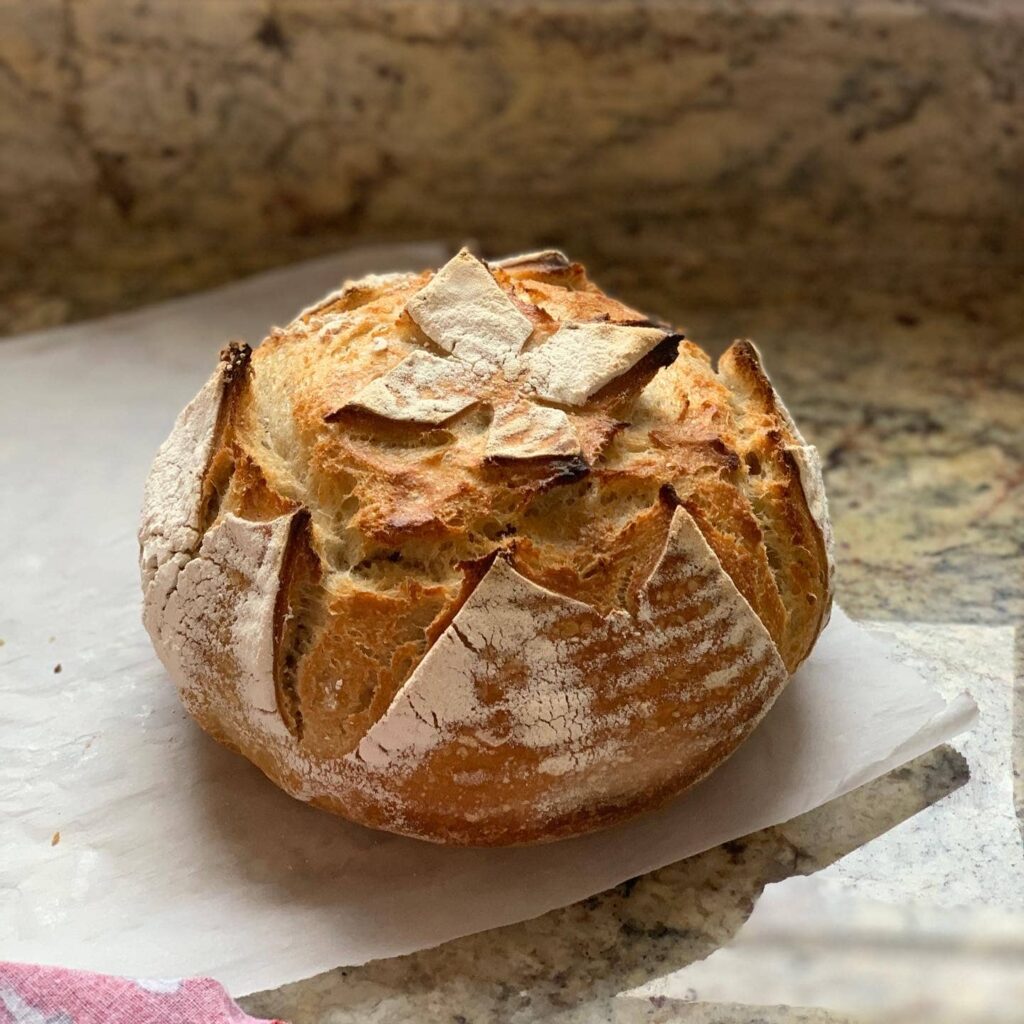
Scoring: Smooth the flour over the top of the cold dough (add a little extra for more contrast if desired). Use a very sharp knife or bread lame to score the dough at an angle. You can do a fancy design or a simple square. The point of scoring is to allow the steam to rise through the bread for a beautiful “oven spring”, but it also makes for a fun look! Scoring cold dough is also much easier than scoring room temperature dough. Score straight from the refrigerator if you can. More tips on scoring dough found here.
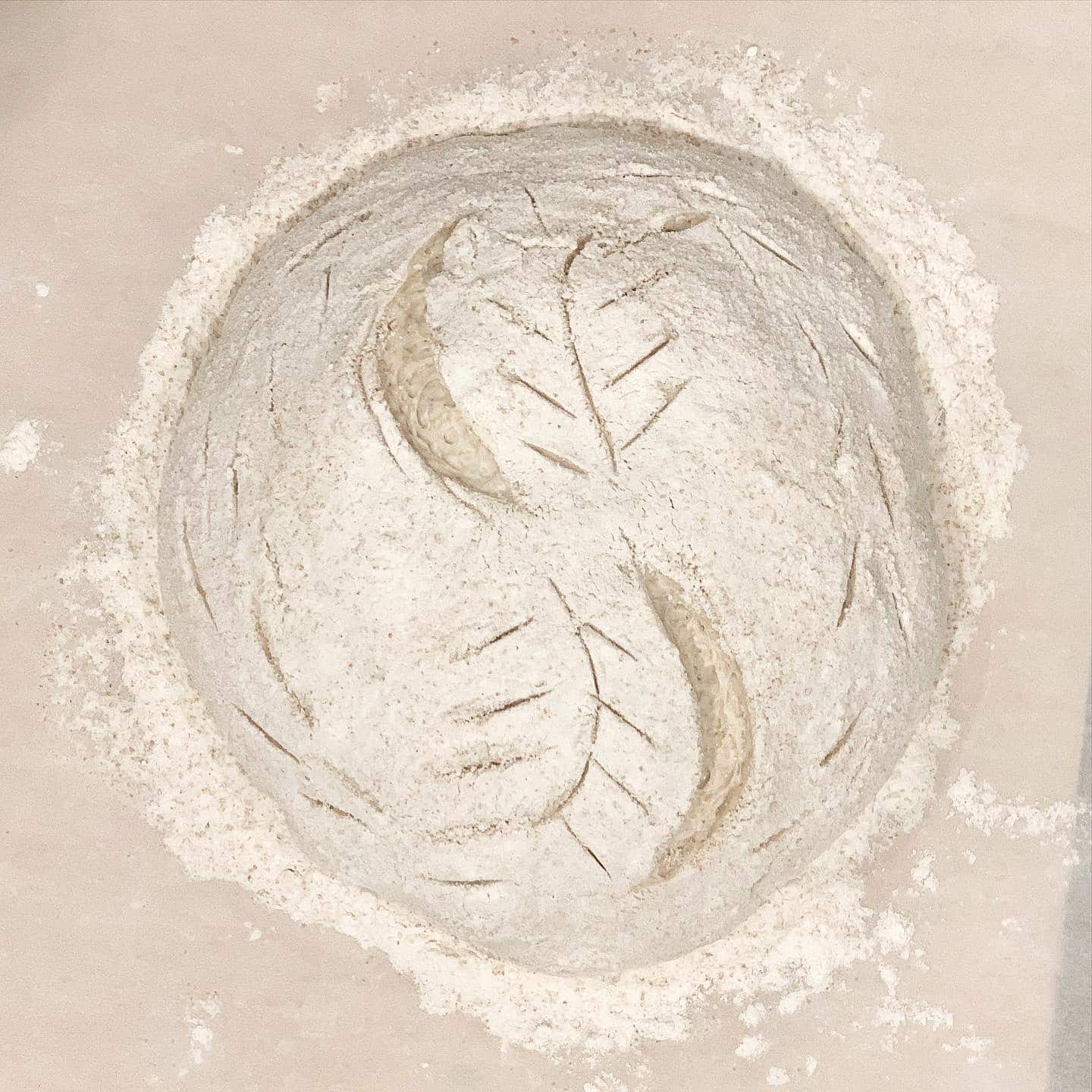
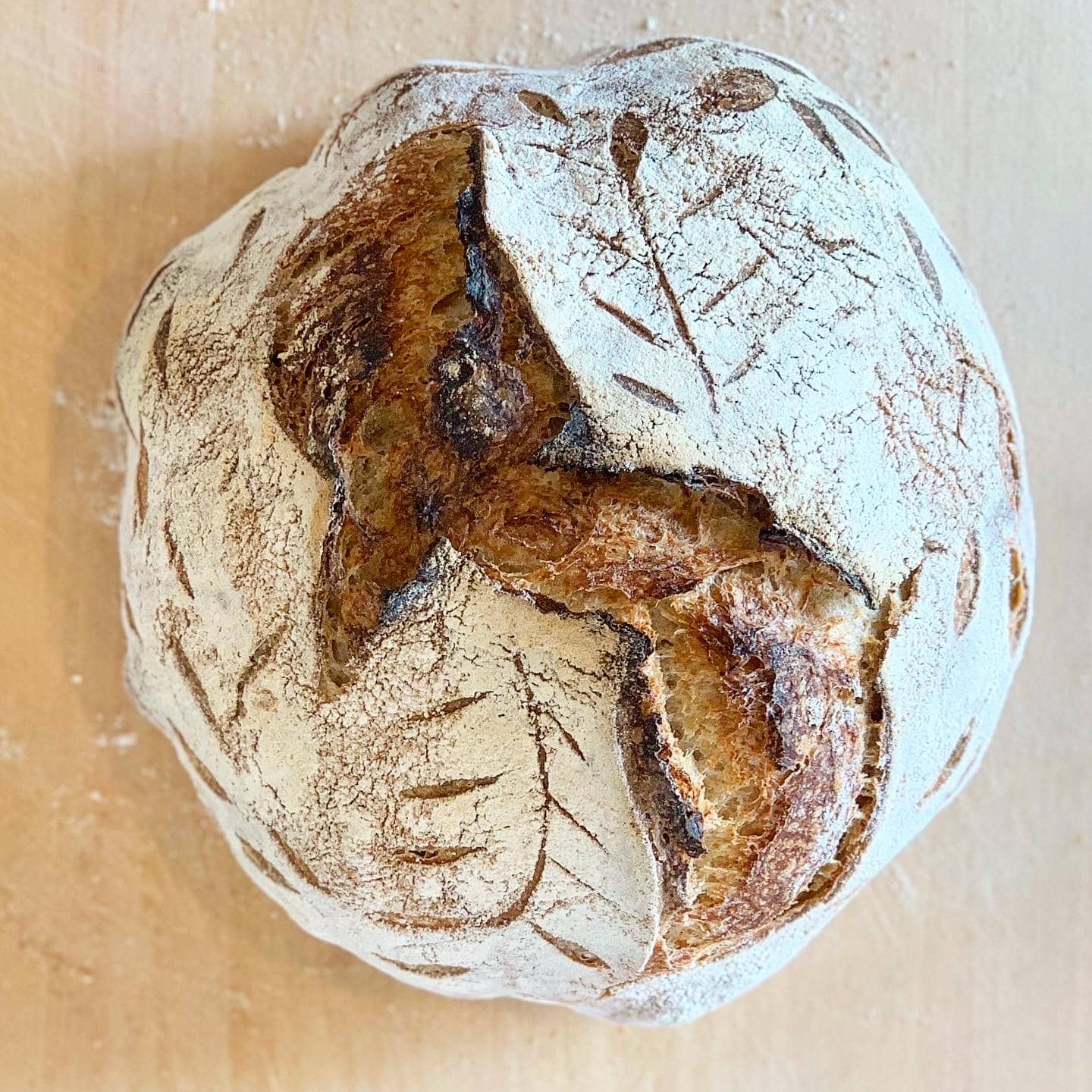

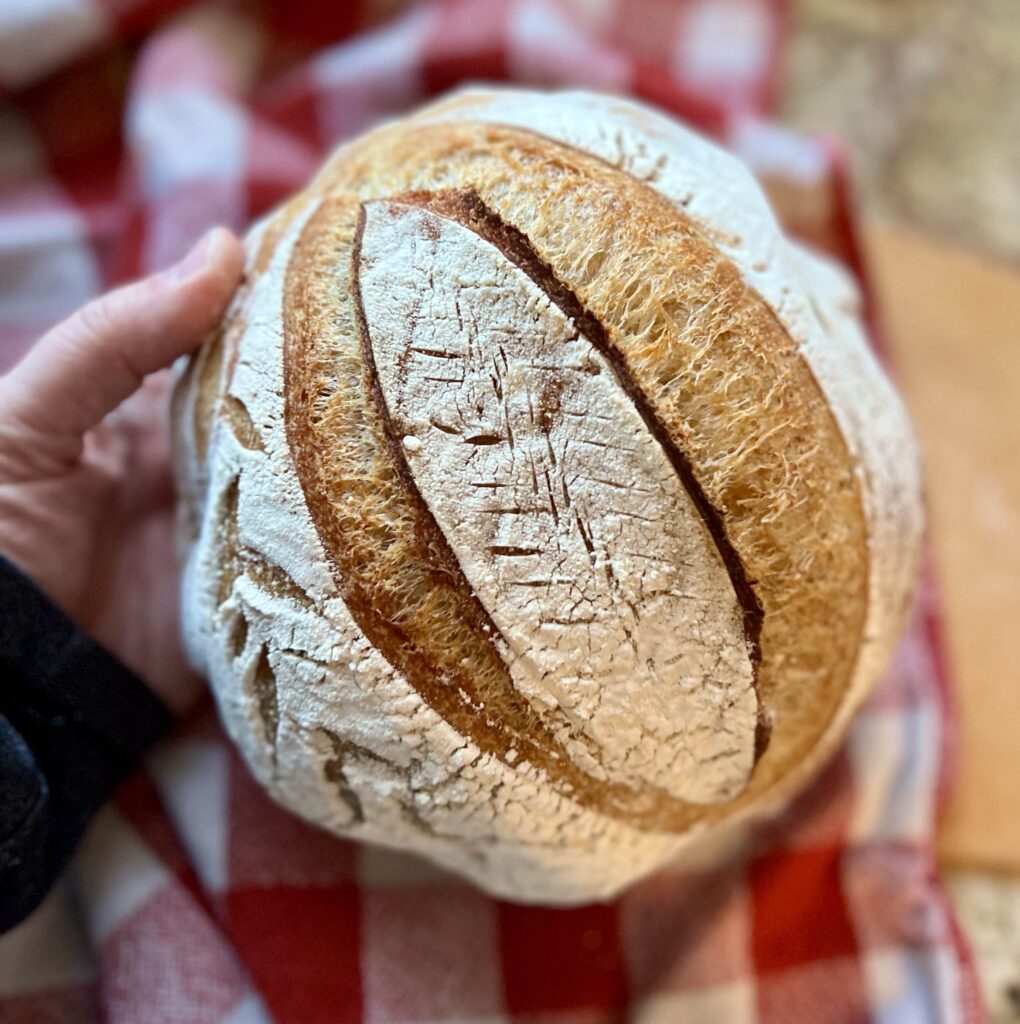

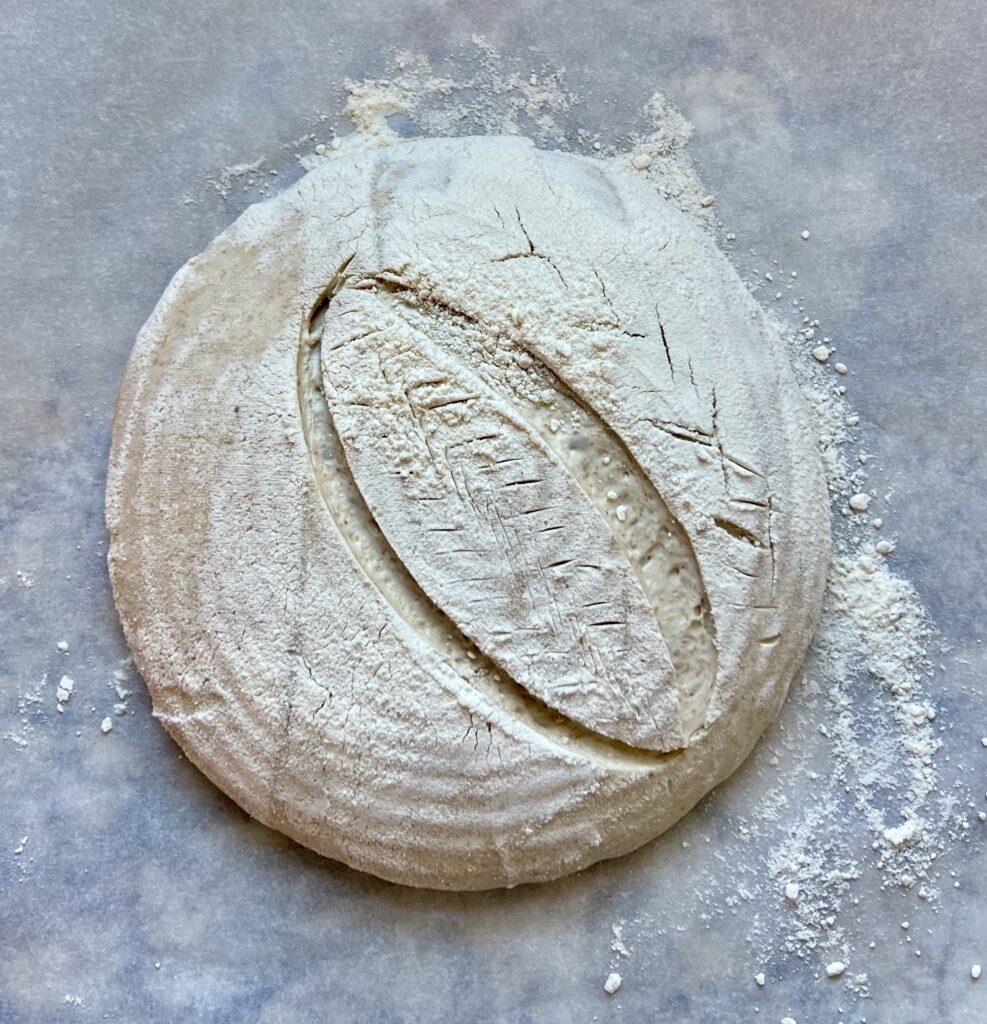
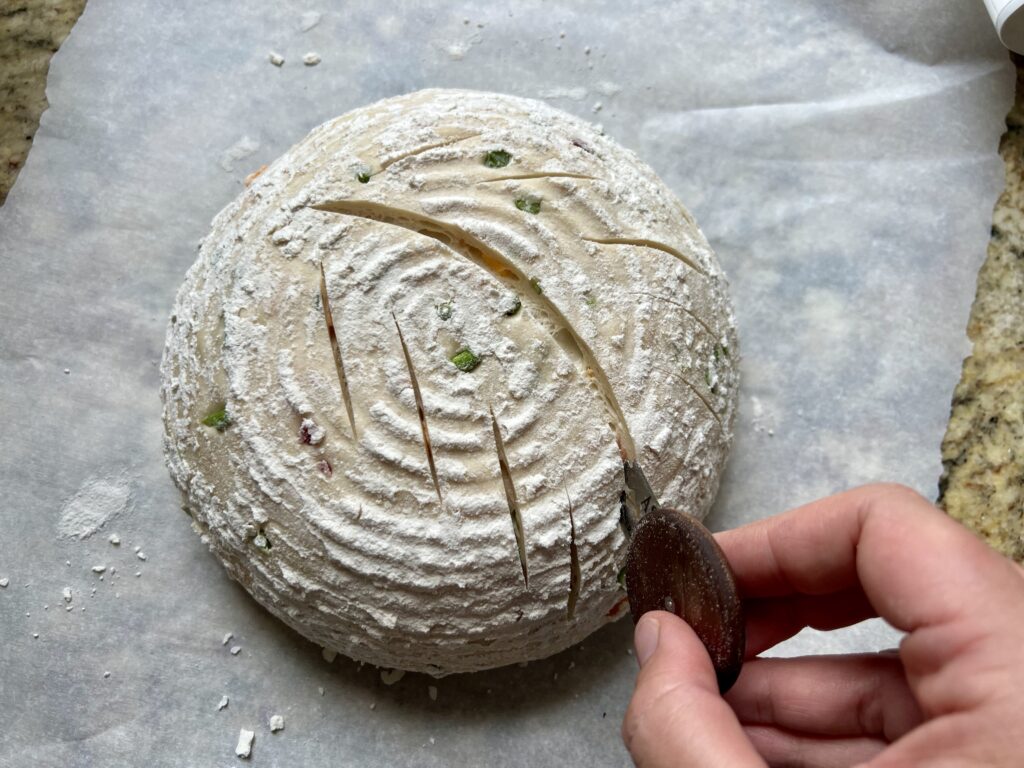
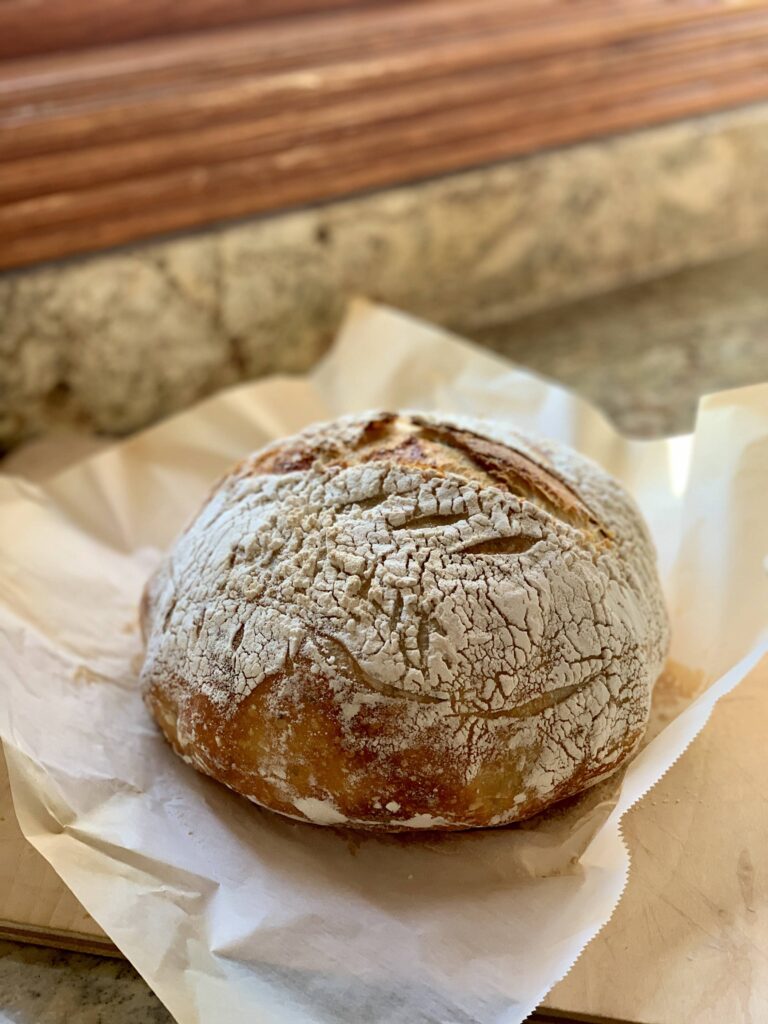
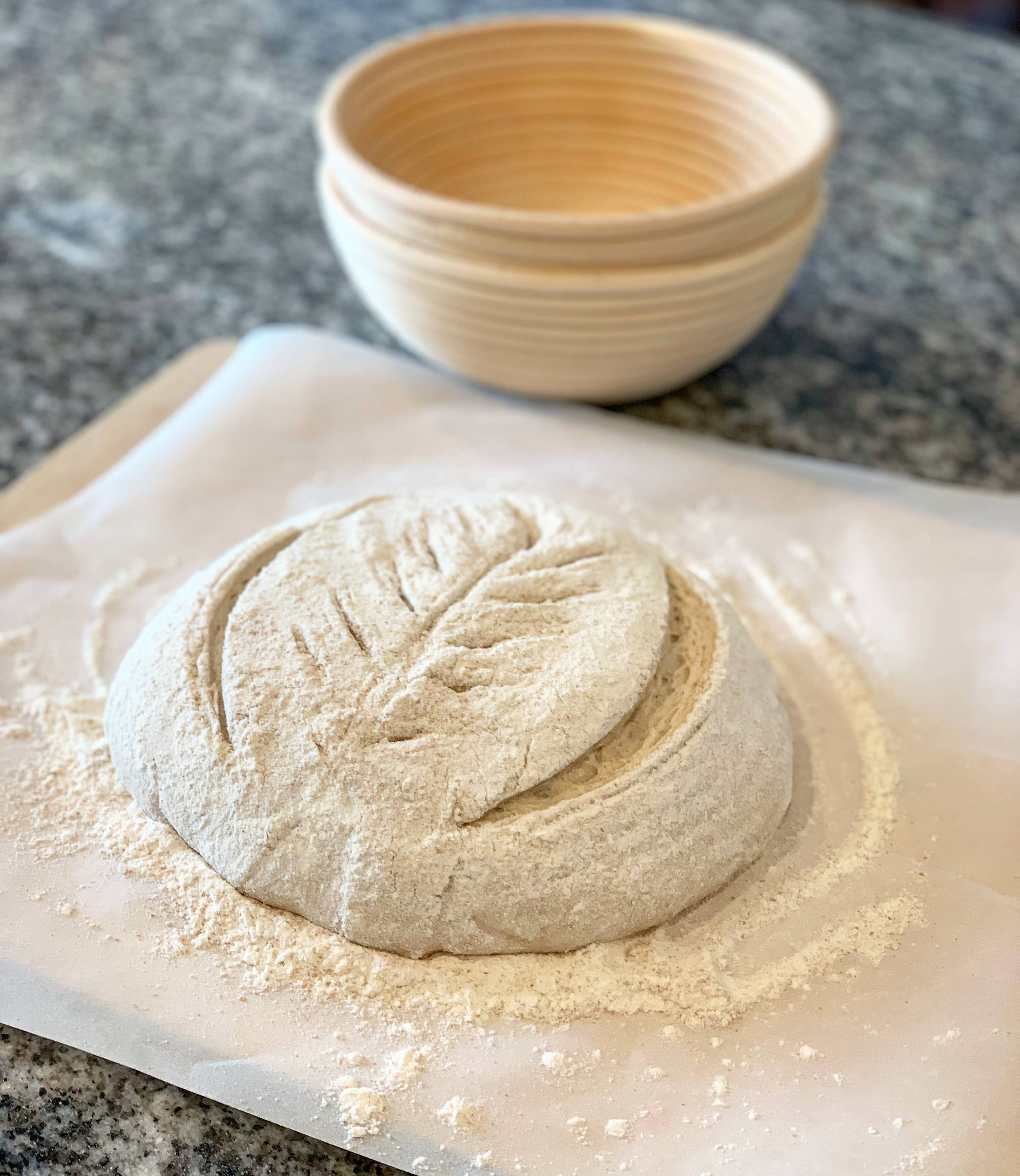
Baking: Carefully remove the dutch oven from the 500 degree oven. Take the top off and place your bread into the dutch oven (including parchment paper–this helps with the transfer). Be very careful not to touch the sides of the dutch oven. Put your hot pads back on before you pick up the lid of the dutch oven and place it on top of the bread. Put the whole dutch oven back into your oven. Lower the temperature to 450 degrees and bake for 25 minutes. Once 25 minutes are up, take the top off the dutch oven. Ooh and ahh over the beautiful oven spring and continue baking for 20 minutes until the bread is a crackly deep brown.
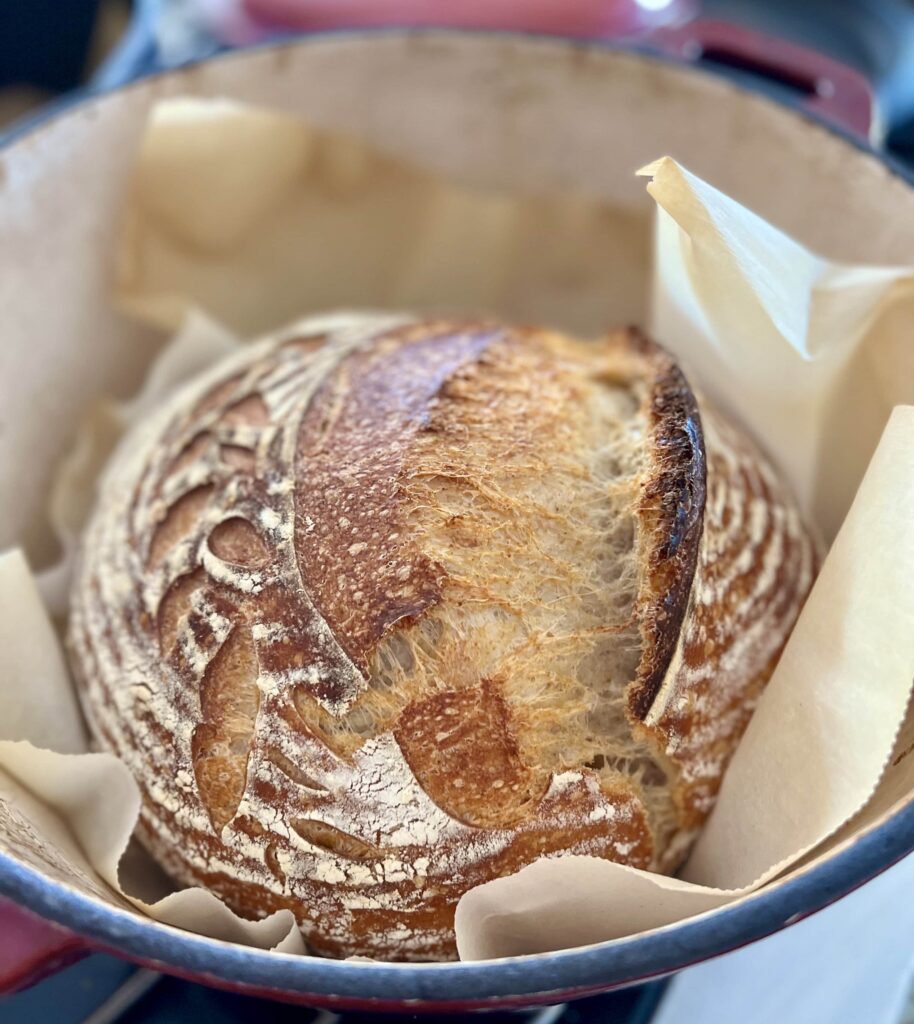
Remove the sourdough artisan bread (and parchment paper) from the dutch oven and place the bread on a baking rack. Preheat your oven to 500 degrees again and place the dutch oven back in the oven to preheat for the next loaf of bread. Preheat again for about 30 minutes. You are building the steam back up in your oven. If you don’t allow it to preheat long enough you won’t have the oven spring you are looking for in your loaf. Follow the same process of scoring and baking your bread as you did above. You can even re-use the parchment paper.
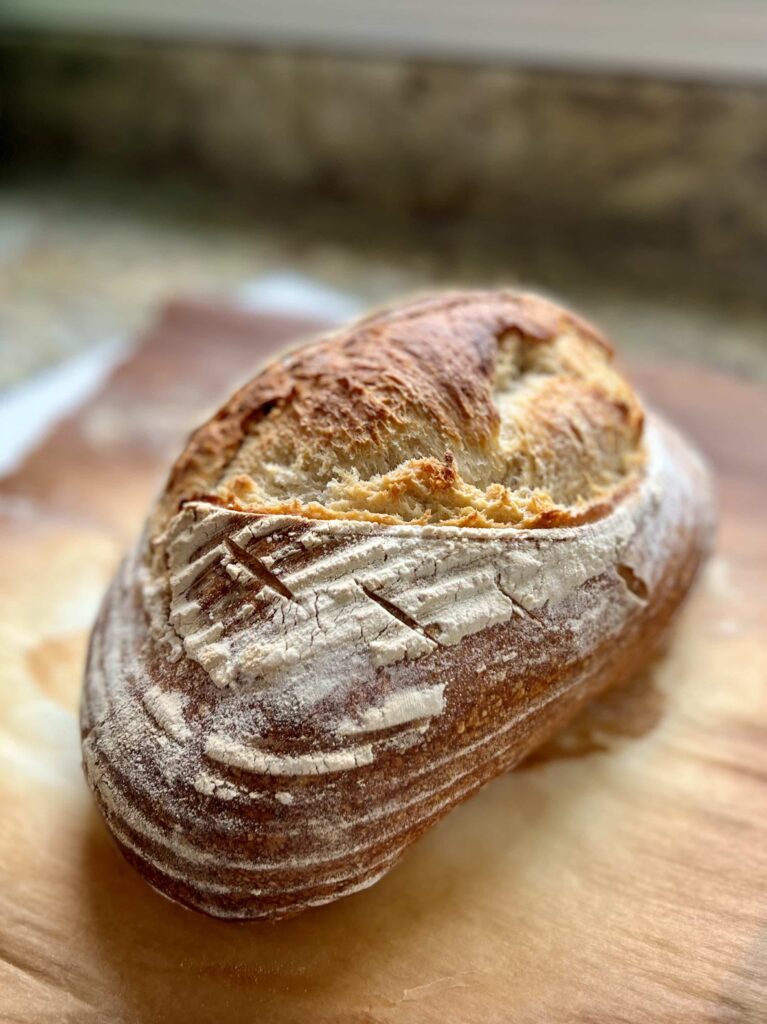
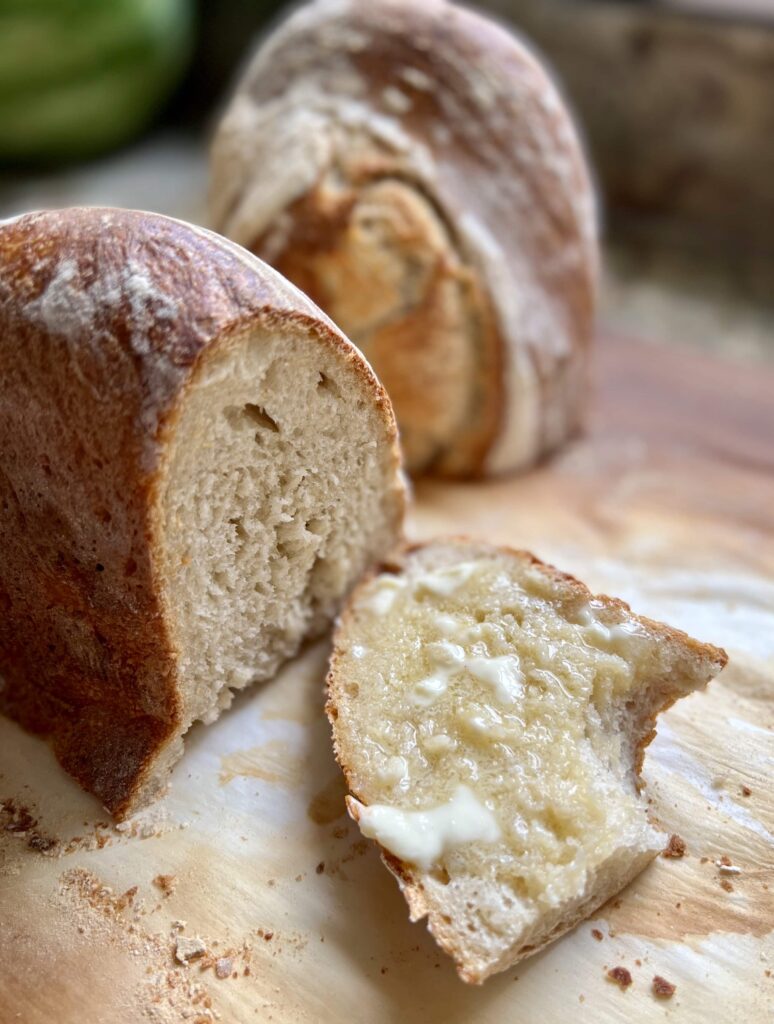
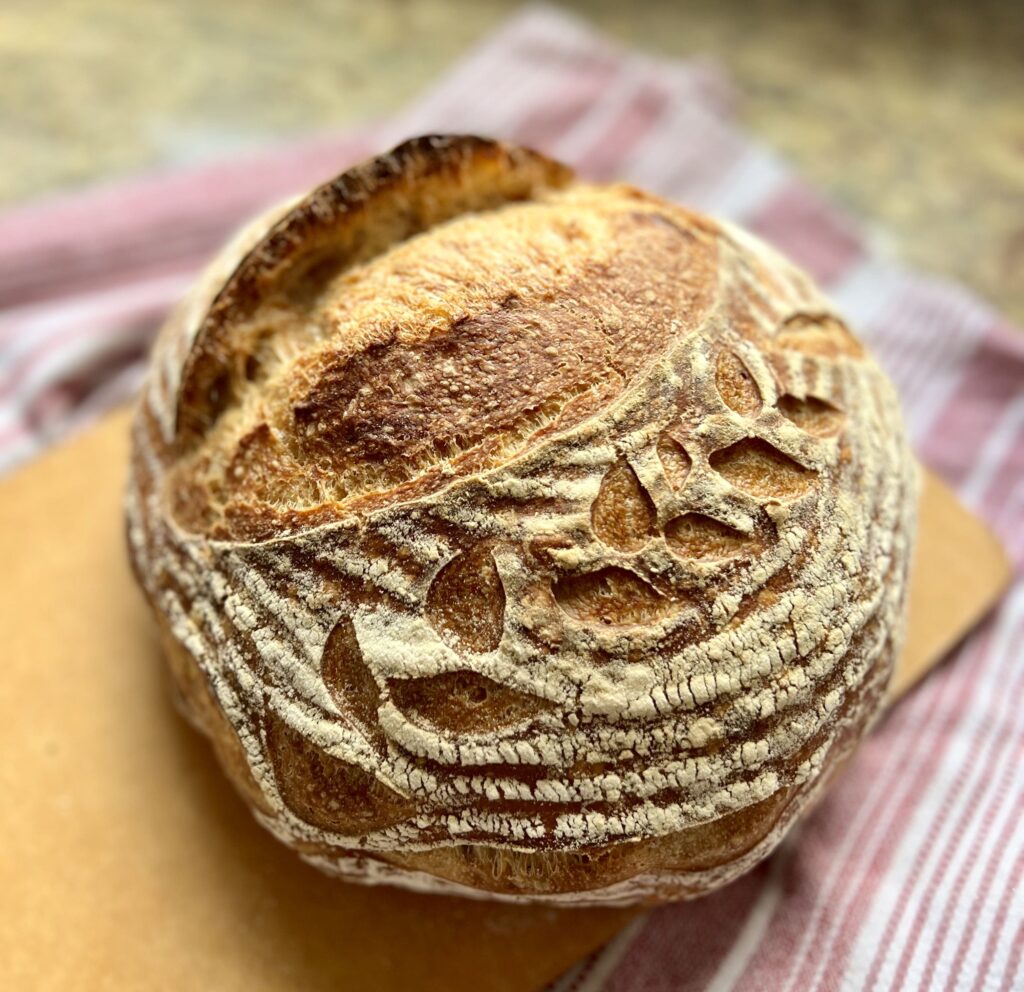
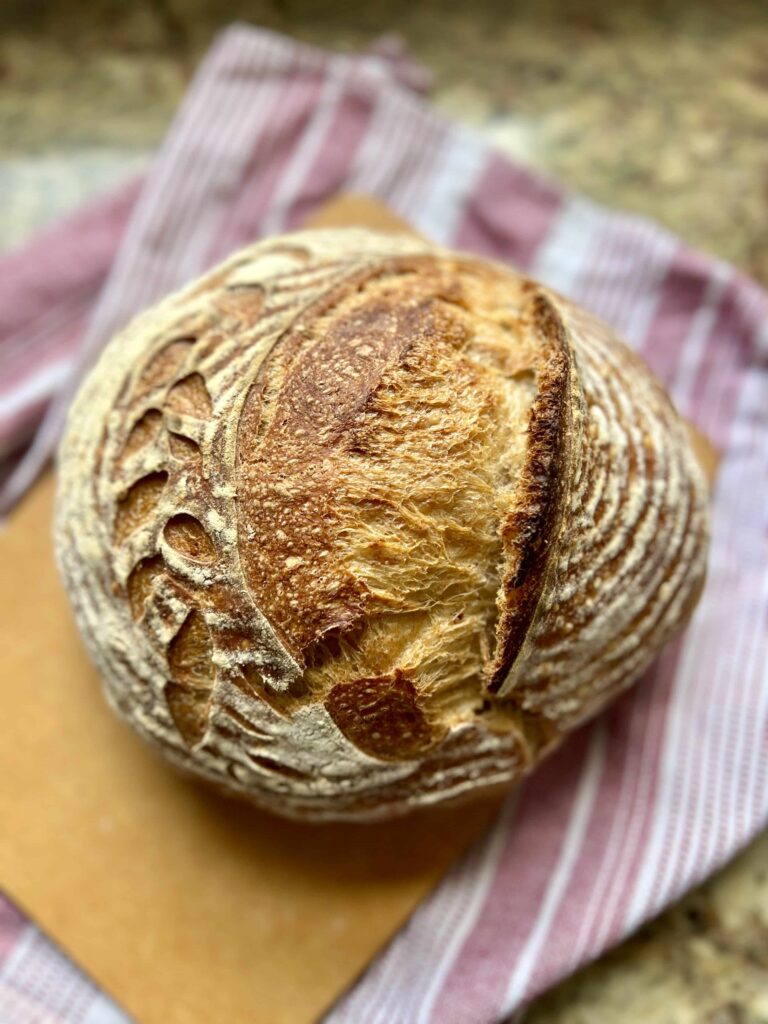
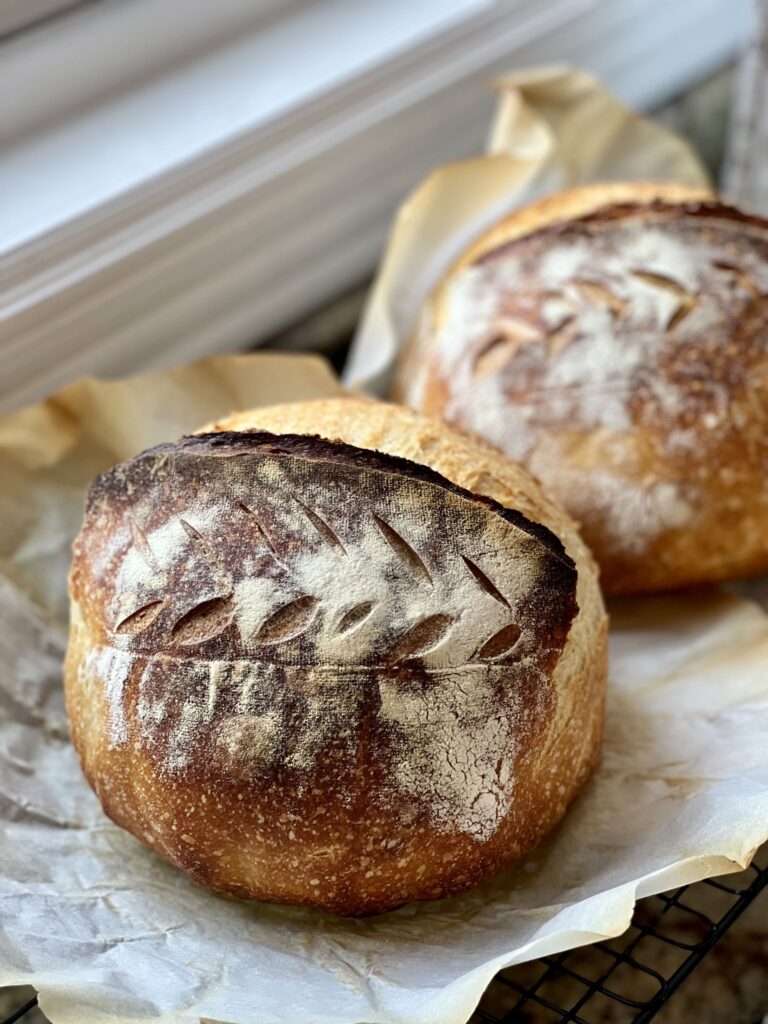
Cooling Sourdough Artisan Bread
Once your loaves have cooled completely, slice into them and enjoy a taste of truly amazing bread. We like to eat them plain, toasted with butter and jam and they make amazing grilled cheese sandwiches. Sourdough artisan bread stays good at room temperature for about 24 hours. After that I like to slice and freeze any extra loaves and toast them when we want a single slice of bread.
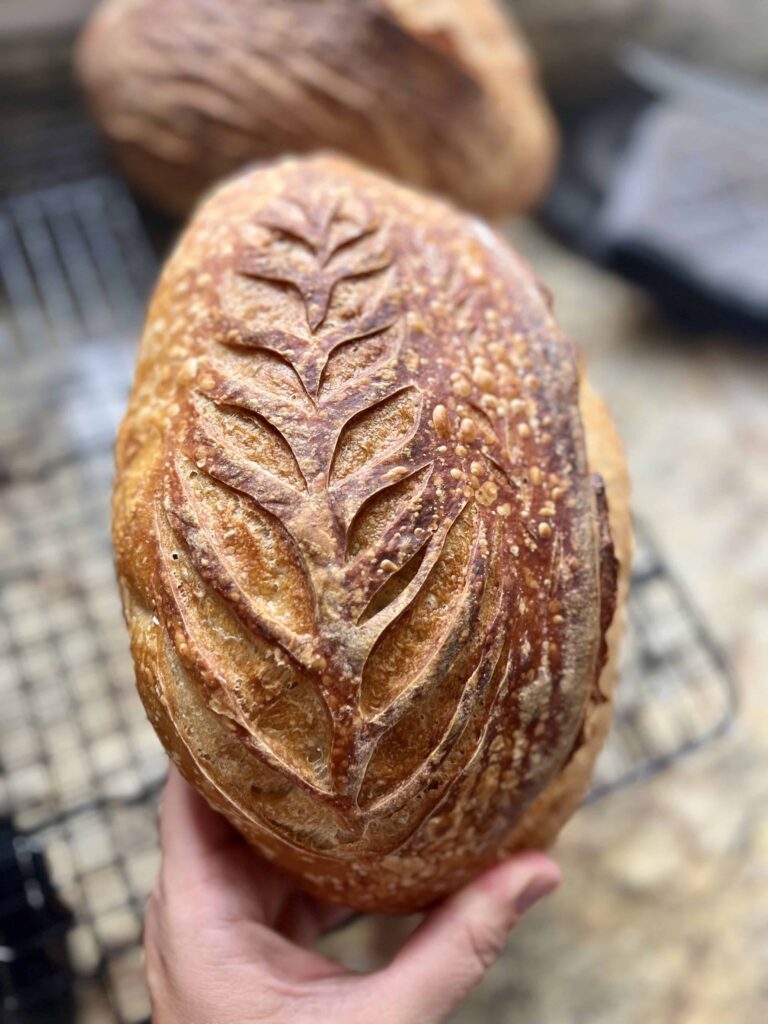
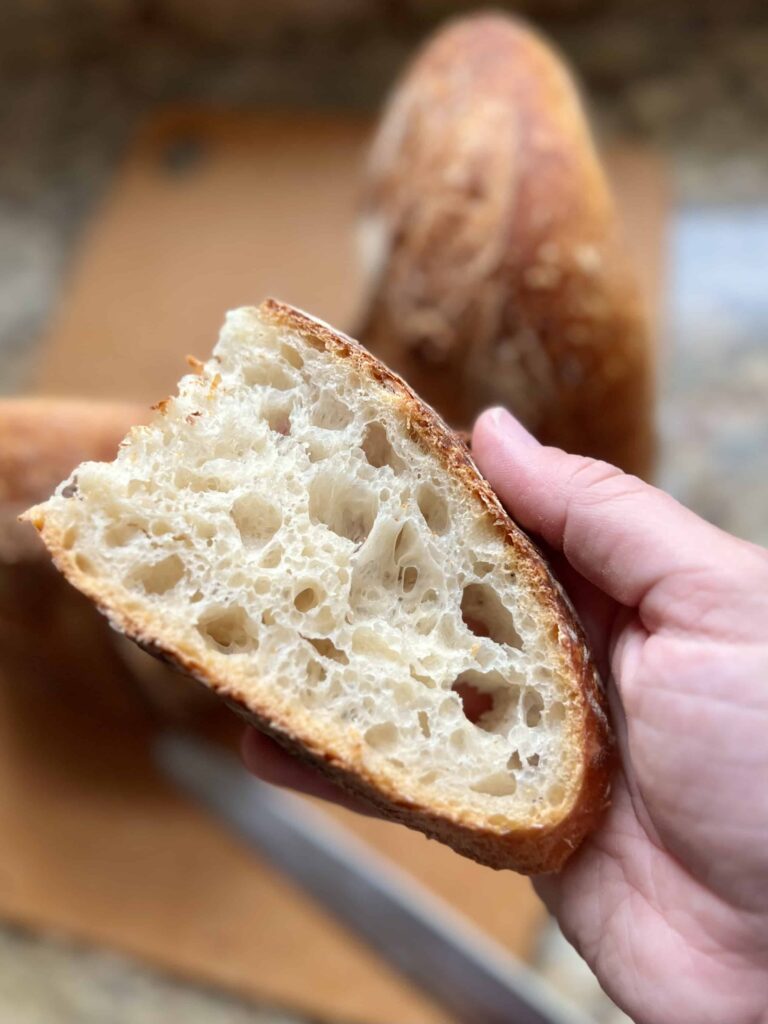
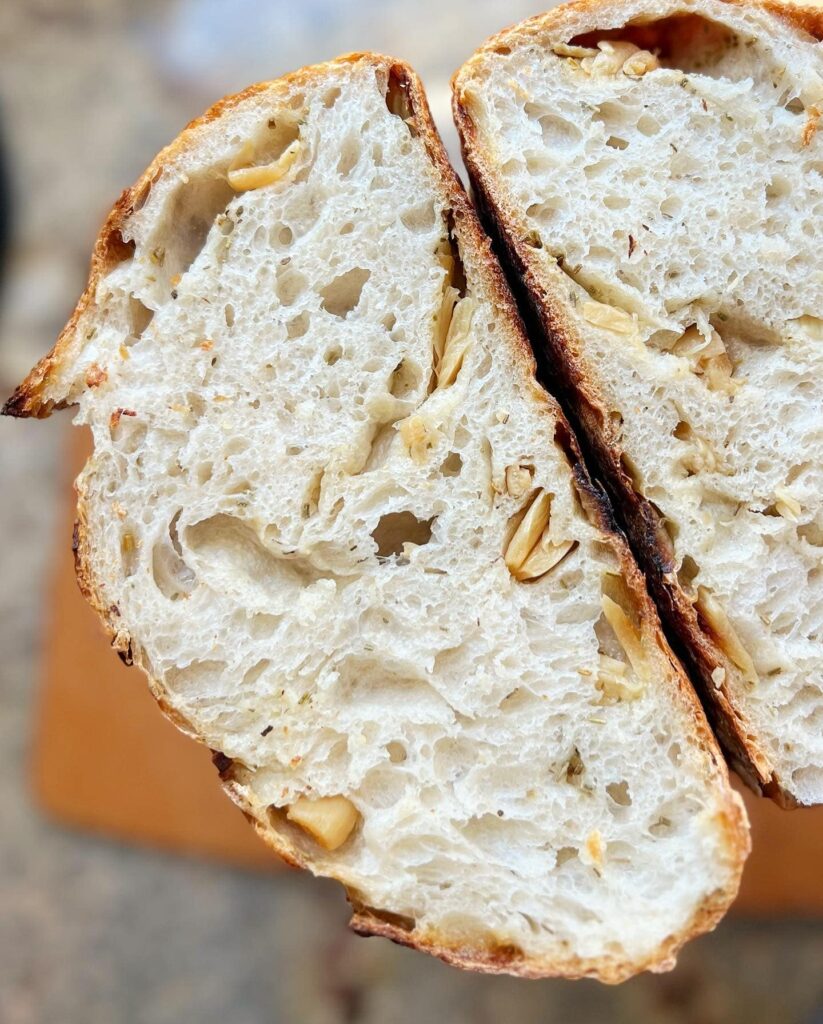
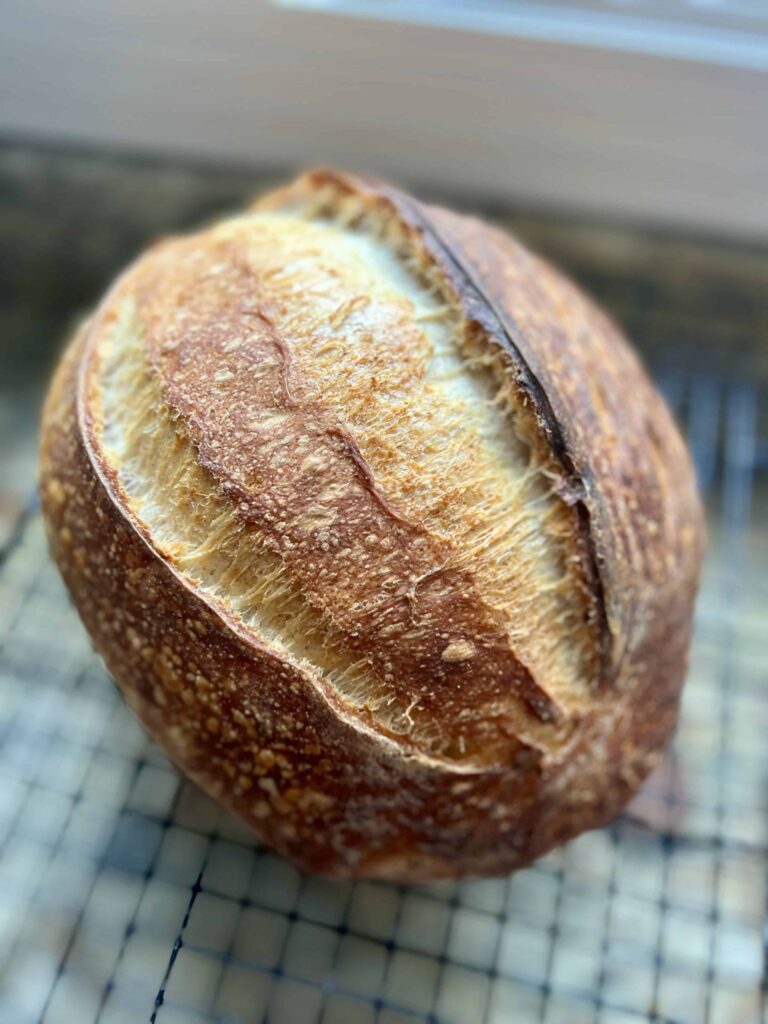

Want more in-depth Sourdough instruction?
Check out my online sourdough classes or take a class in person.
Frequently Asked Questions
The float test is not always the best indicator of readiness. It can give false positives as the levain is ripening. The test is still a good general indicator, though. To perform. the float test, fill a clear cup with some room temperature water. Take a little drop of your ripe leaven and plop it in the cup. If it floats, you are ready to proceed with the recipe. If it sinks, it either hasn’t risen long enough, or it has risen too long. If you think it needs to rise longer (for example, it has only risen a few hours or has been rising in a cold kitchen overnight), test again in another hour. If it has risen too long, you can still use this leaven, but your bread may end up with more “sour” notes.
This is an advanced sourdough recipe. If you’re looking for something a little easier and still delicious, try this beginner sourdough recipe.
Sourdough starter and levain are typically made up of the same ingredients: flour and water. It is their PURPOSE that is different. Sourdough starter is meant to be fed daily or weekly (if refrigerated) the same ratios, keeping the wild yeast and bacteria happy rising and falling. Levain is made for a specific recipe. Sourdough starter is always used to build or create a levain for a specific bread recipe. Some levains have sugar in them. Others have different blends of flours. Using a levain allows you to build the perfect combination of flour/water for that specific bake.
Get started with Sourdough:
Watch the Process
Watch the whole process on this video. This video was taken in 2020, so some of my processes have been refined and changed a bit, but the general overview is helpful so I’m leaving it up. If you want up to date video instruction that takes you step by step and teaches you this recipe start to finish, check out my sourdough artisan bread mini course.
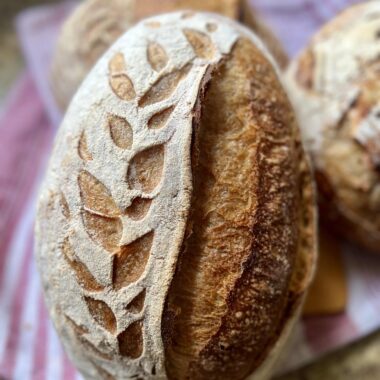
Sourdough Artisan Bread
Ingredients
Levain (12 hours before)
- 12 grams ripe sourdough starter
- 120 grams bread flour
- 120 grams water
Sourdough Artisan Bread
- 200 grams levain
- 750 grams water 50 grams reserved for AFTER the fermentolyse
- 900 grams bread flour
- 100 grams whole wheat flour
- 20 grams salt
Instructions
Day 1: Evening, Make Levain (78 degrees)
- Mix together ripe sourdough starter, bread flour and water. Set aside to ripen for 10-12 hours.
Day 2: Mix Dough/Bulk Fermentation/Shape/Cold Bulk Fermentation (78 degrees)
- Fermentolyse: Once the levain is peaked and active (bubbly, doubled in size, milky sweet smell), mix 200 grams levain with 700 grams of water in a large bowl. Warm the water if the ingredients are too cold and cool the water if ingredients are too warm. Add the 900 grams bread flour and 100 grams whole wheat flour to the bowl and mix until incorporated and a shaggy dough forms. Let rest for 30 minutes.
- Mixing: After 30 minutes, add the reserved salt and 50 grams of water. Combine using your hands by squeezing the dough between your fingers, pinching chunks of dough and reincorporating together. The dough will break apart and then reform in the bowl through this process. Pick up one side of the dough and fold it over on itself. The dough will be sticky. Wet your hands as needed and continue to work with the dough until all the salt and water has been incorporated. This can take about 3-5 minutes until the dough is cohesive and strong. Transfer the dough to a plastic container or a glass bowl if desired.
- Bulk Fermentation: Perform 3-4 sets of "stretch and folds."
- To “stretch and fold,” wet your hand (so it doesn’t stick to the dough). Reach down to the bottom of the bowl of dough and pull the dough up and over the top of the dough. Turn the bowl 1/4 turn and repeat the stretch and fold. Turn another quarter turn and repeat. Perform one more 1/4 turn with stretching and folding the dough. Cover and set aside.
- Repeat the stretch and folds every 30 minutes for the first two hours.
- Let the dough rest in a warm place, for the rest of bulk fermentation, about 1 1/2 – 2 hours at 78 degrees. During this time the dough will puff up about 30-40%, become more aerated, start to pull away from the edges of the bowl and have a few scattered bubbles around the edges/top of the dough. If you dough is not showing these signs, make sure it's warm enough and give it another half an hour or so until it is showing those signs that it's ready to shape.
- Divide: Tip the bowl upside down, allowing the dough to fall onto a clean counter surface. Be gentle to avoid cutting and degassing the dough as much as possible. Use a bench knife to cut the dough into two equal portions.
- Pre-Shape: Wet your hands and the bench knife. Push the bench knife under the dough while using your free hand to tuck the dough under itself. Repeat this process going around in a circle until you have a tight ball of dough. Repeat with the second loaf.
- Bench Rest: Let the dough rest uncovered for about 30 minutes at room temperature. The dough will flatten a bit during this period of time.
- Shaping: After the dough has rested for about 30 minutes it is time to shape the bread into a round. Sprinkle flour on top of the dough. Using the bench knife, lift the dough up off the counter and place it on top of the countertop–floured side down. This ensures that the flour is staying mainly on the outside of the dough. Going around in a circle, pull the dough sideways towards you and then fold up to the top of the round. Move 90 degrees and repeat the same process pulling the dough sideways and then folding up to the top. As you continue this process around the dough, increase the tension as you pull. Gather the bread into a circle and use a bench knife to lift the bread and place into your lined bowl.
- Cold Fermentation: Cover the dough with plastic wrap or a reusable cover and store in the refrigerator overnight or for up to 12-24 hours. Alternatively you can let your dough rise outside the fridge for another 3-4 hours, keeping the dough at that 78 degree F temperature, and then bake your loaves the same day.
Day 3: Bake
- Pre-heat the Oven: Put a dutch oven (top and all) into the oven and preheat to 500 degrees. Allow the dutch oven to heat for about 30 minutes to an hour at 500 degrees.
- Once preheated for 30 minutes, pull your first loaf out of the refrigerator. Remove the plastic wrap (this is easy to do straight out of the refrigerator if the dough is chilled–not easy if the dough warms up) and place a piece of parchment paper on top of the bread dough. Flip the dough over so that the dough is now sitting on the parchment paper. Take off the bowl/banneton and kitchen towel.
- Scoring: Smooth the flour over the top of the dough (add a little extra for more contrast if desired). Use a very sharp knife or bread lame to score the dough.
- Bake: Carefully remove the dutch oven from the 500 degree oven with hot pads. Take the top off and place your bread into the dutch oven (including parchment paper–this helps with the transfer). Be very careful not to touch the sides of the dutch oven. Put your hot pads back on before you pick up the lid of the dutch oven and place it on top of the bread. Put the whole dutch oven back into your oven. Lower the temperature to 450 degrees and bake for 25 minutes. Once 25 minutes are up, take the top off the dutch oven and continue baking for 20 minutes until the bread is a crackly deep brown. The loaf should register between 205-210℉ when it's finished baking.
- Remove the baked loaf from the dutch oven and pre-heat the dutch oven again for 15-20 minutes. Score the second loaf and bake according to the same directions. Let cool and enjoy!

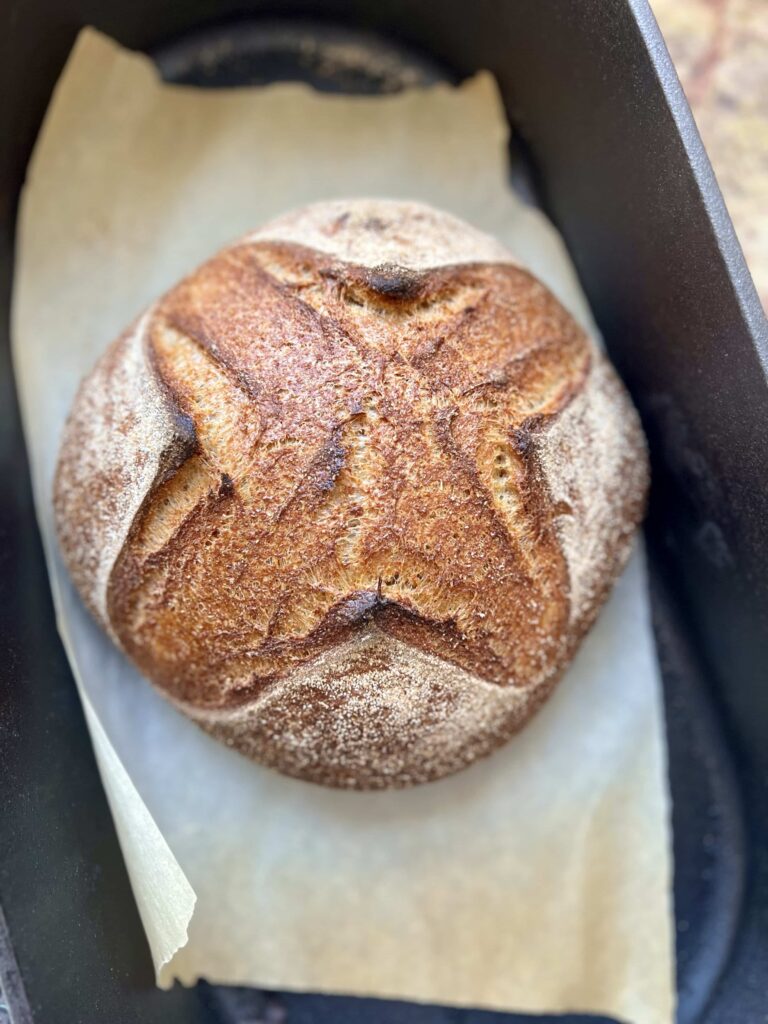
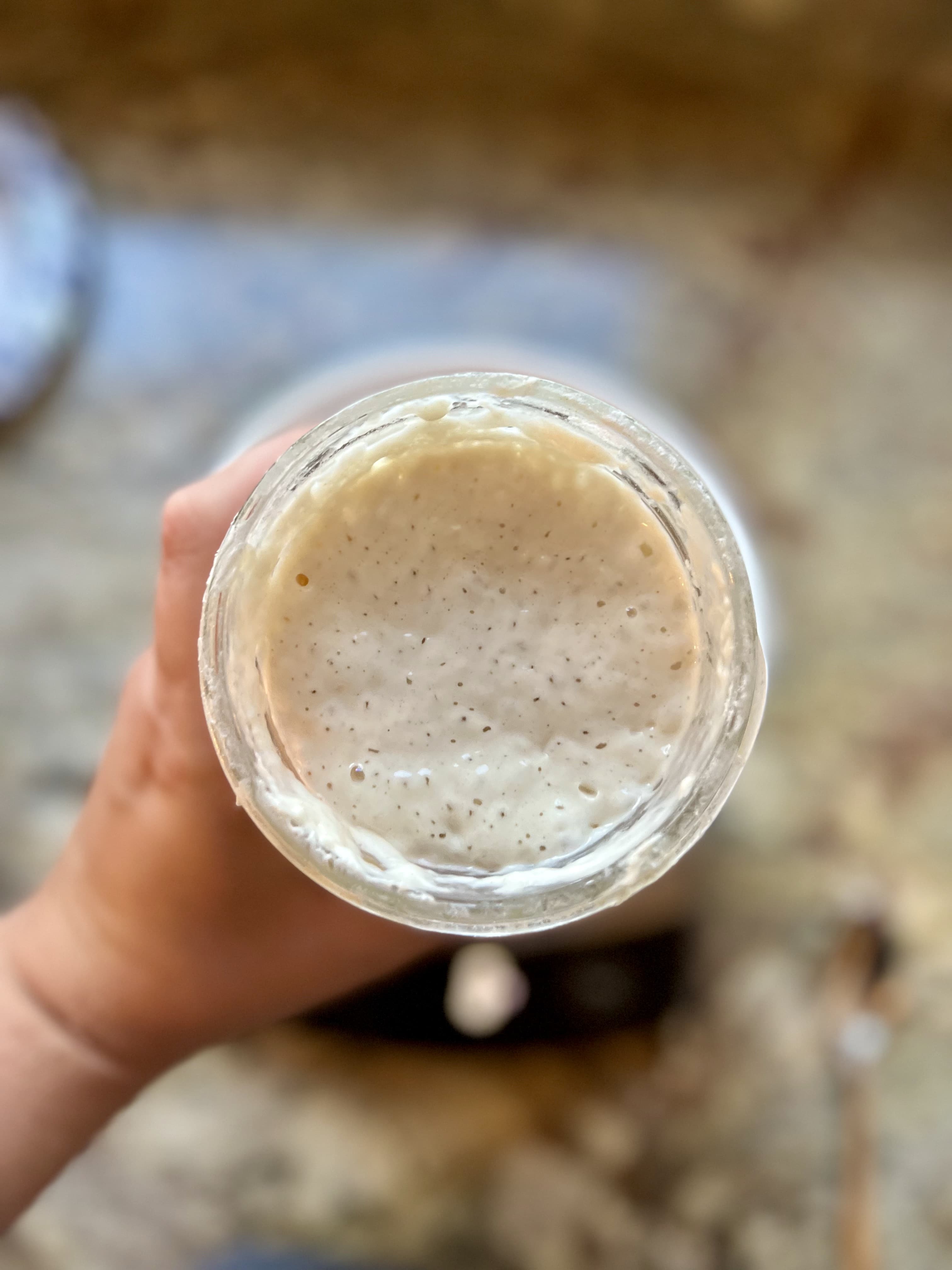
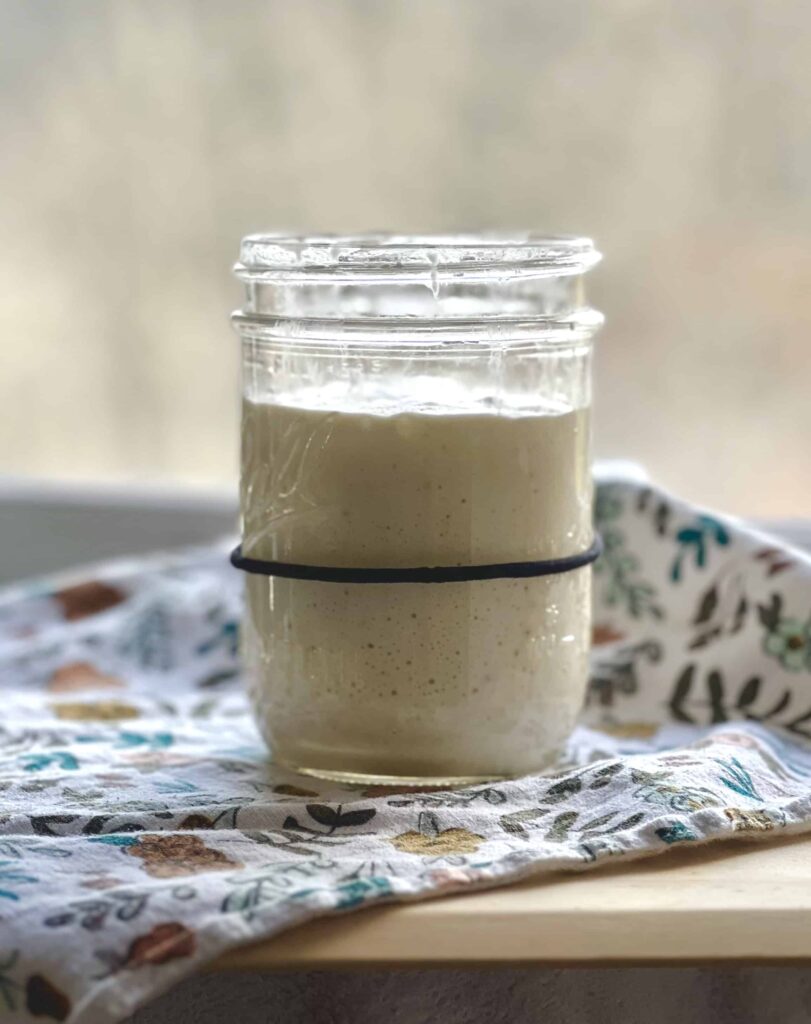
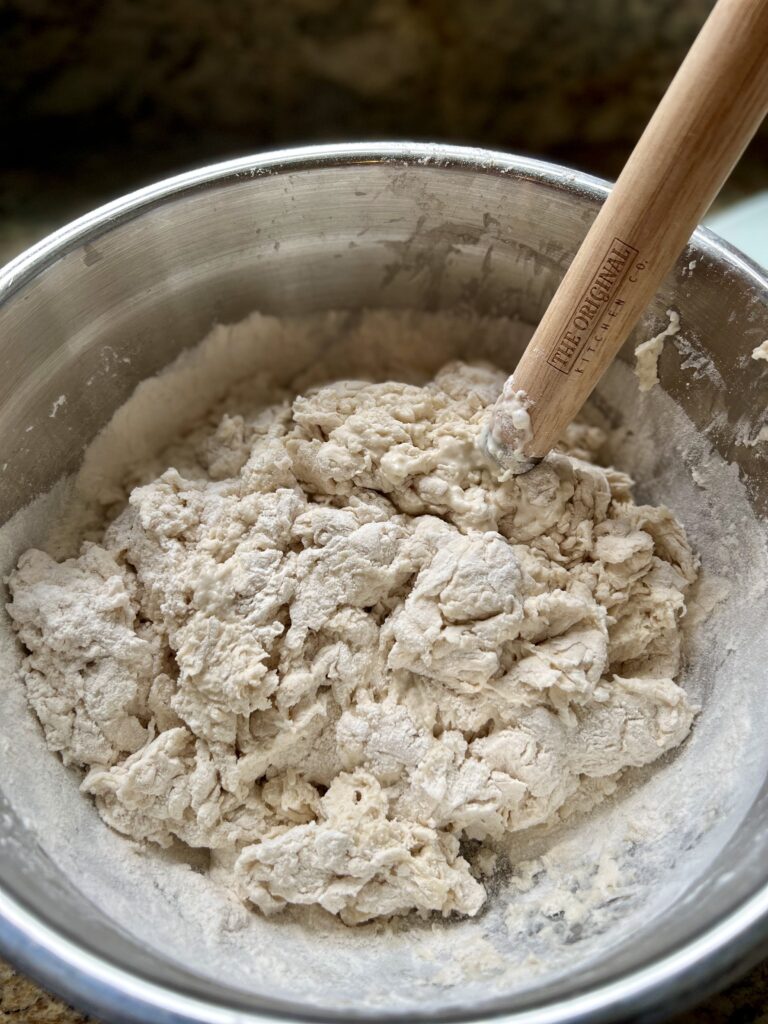
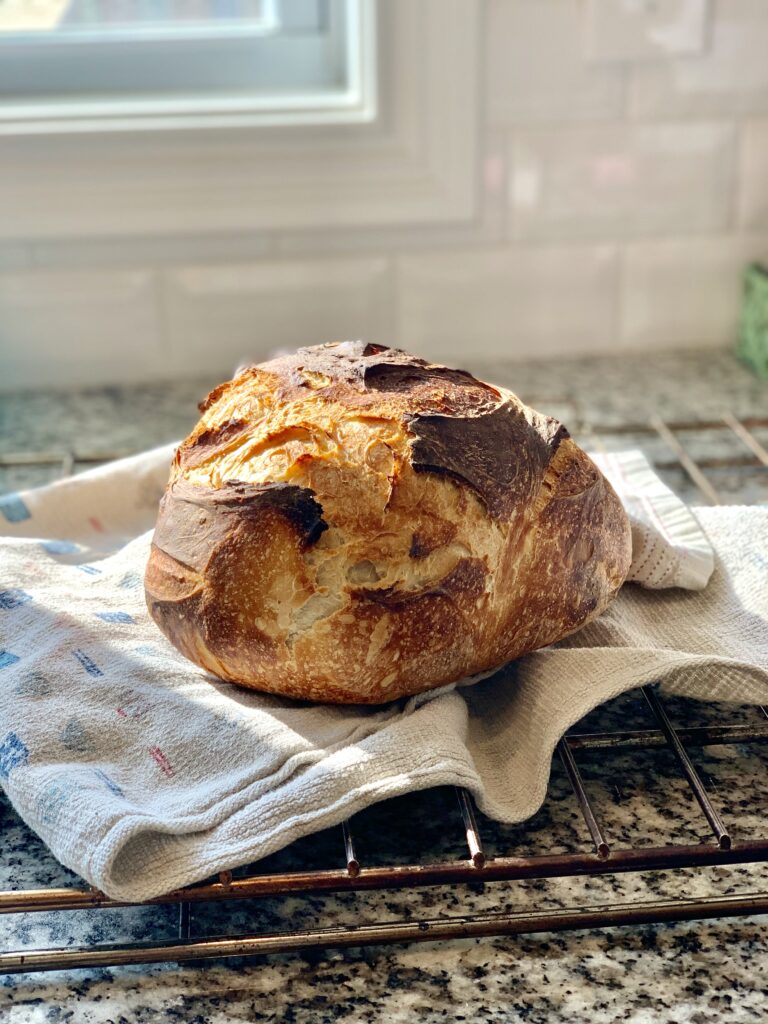
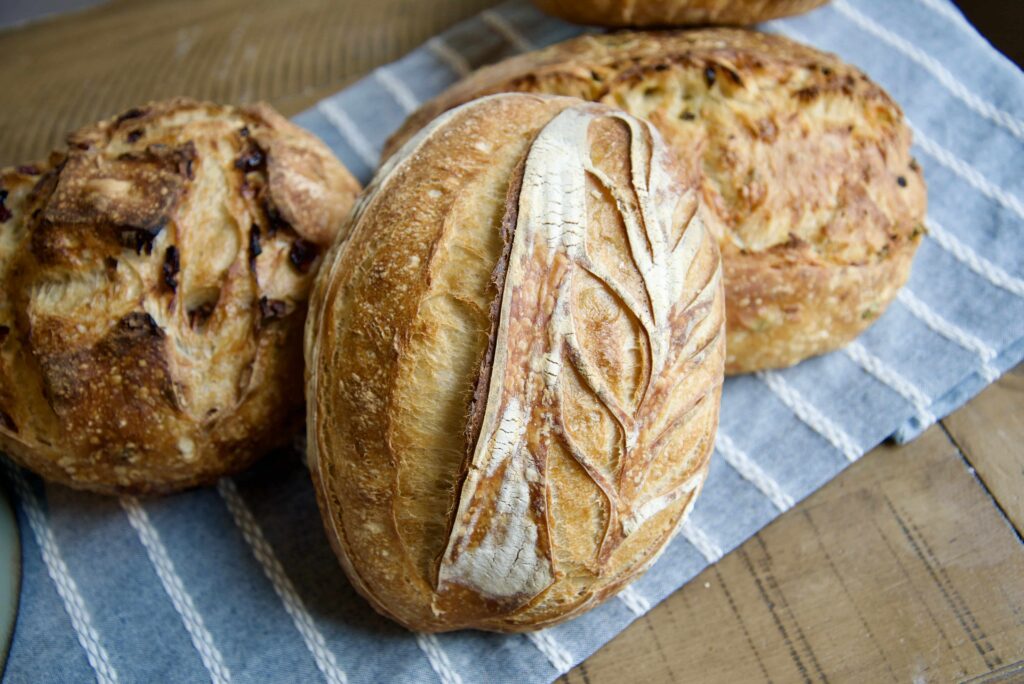
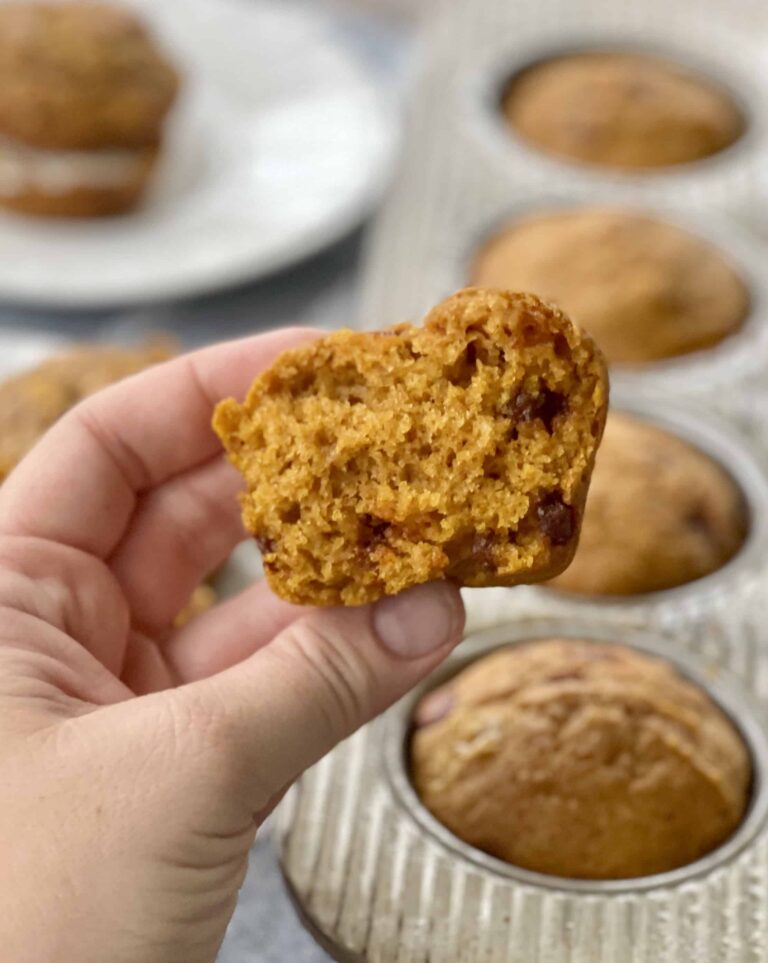
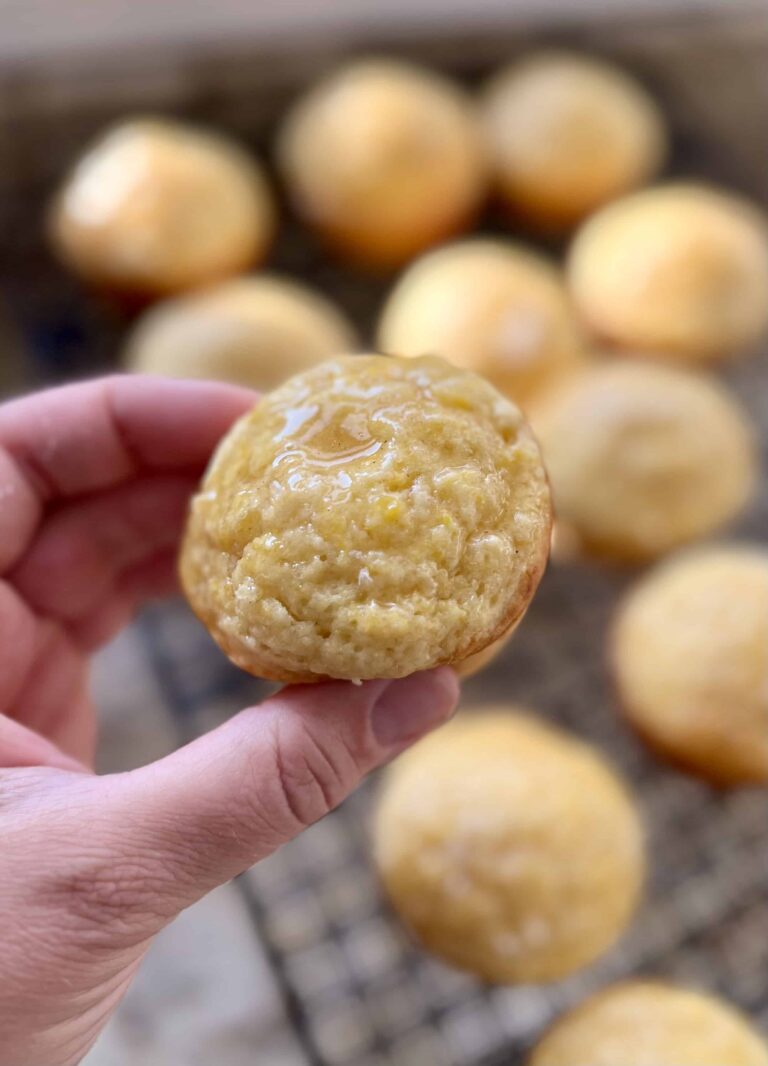
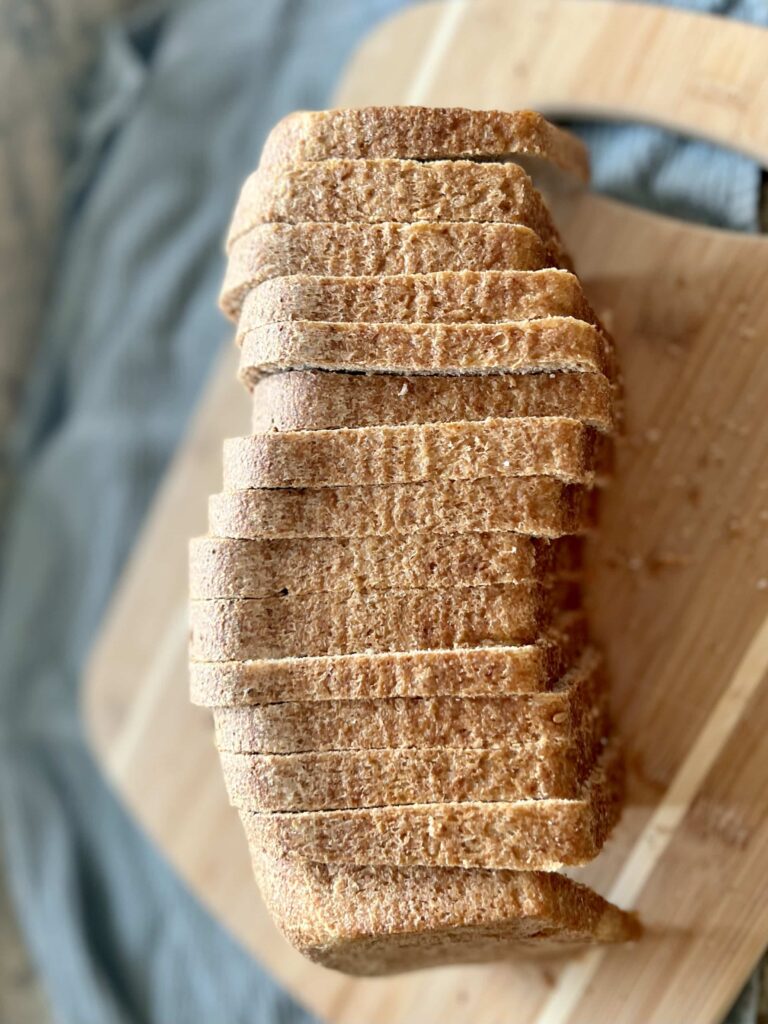
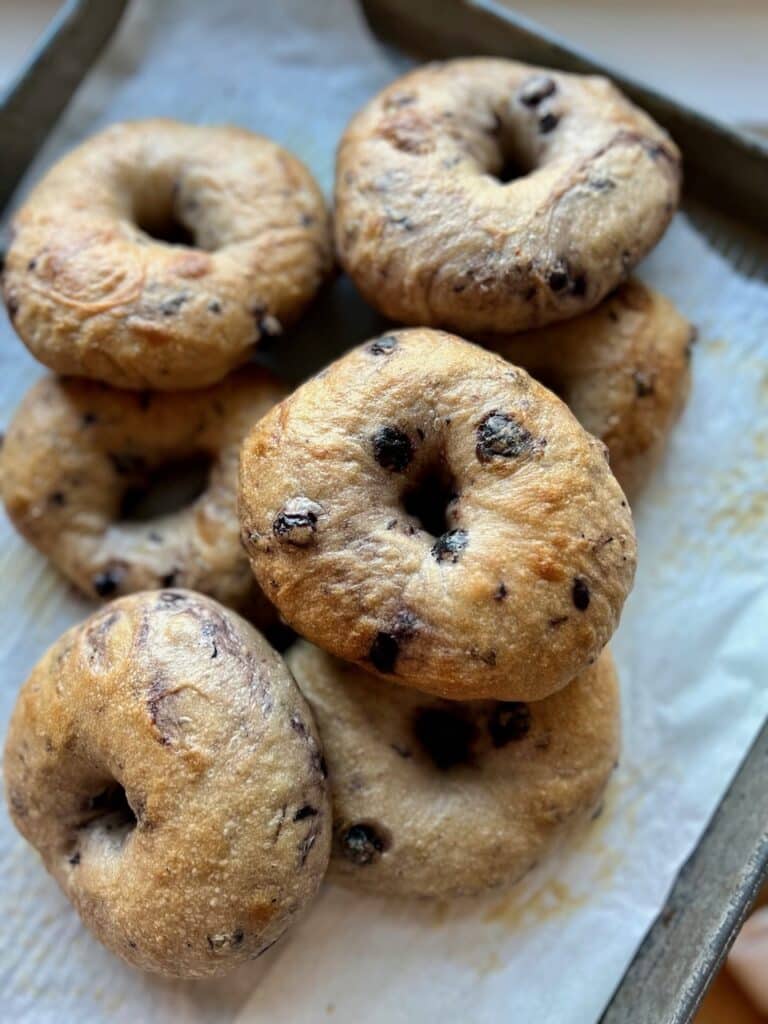
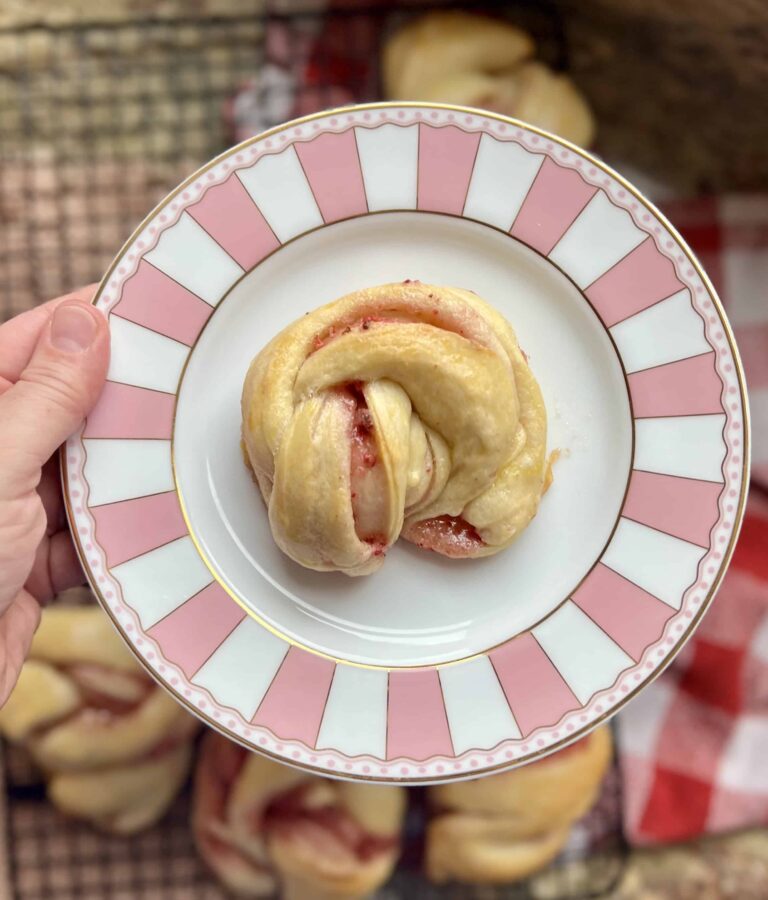
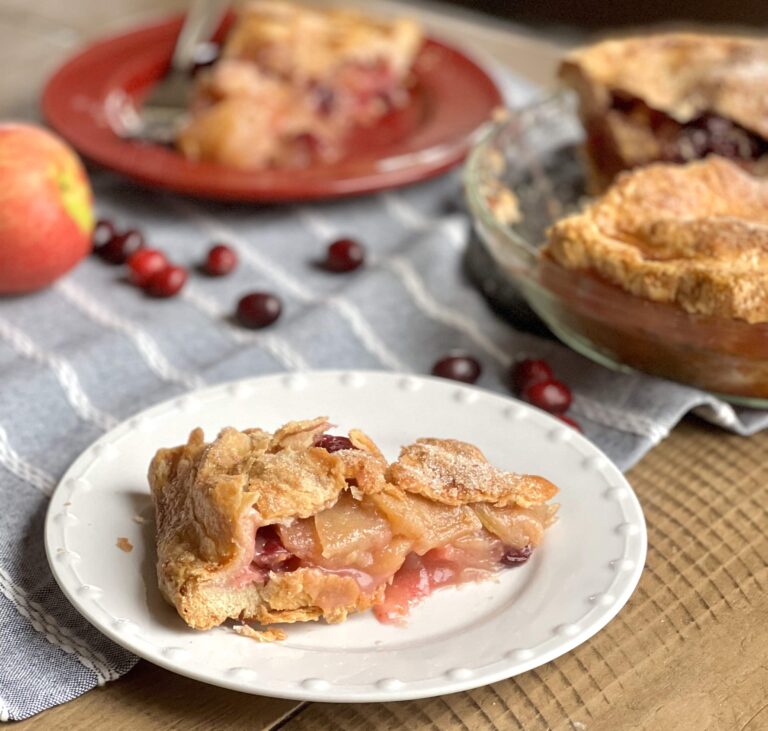
Everything seemed perfect but my loaves lacked oven spring. I don’t get it. Any ideas?
From my experience, I would check that bulk fermentation was properly accomplished, and that the starter or levain was very strong and active
I discovered my frig temp was 32 degrees. I think that was the issue. No proofing happening overnight.
This is the best recipe I have made so far! My loaves had such wonderful spring and texture. Thank you for sharing! At what stage would you recommend I add in any mix-ins to the loaf?
If I wanted to bake it as one loaf, how would I do that? Just make sure it fits in a larger Dutch oven? And probably bake longer?
I haven’t baked this as a loaf, but I would probably shape it, place it in a loaf pan and let it rise. Then bake it with steam for about the same amount of time.
Thanks for posting this great looking recipe I am looking forward to trying it. I was just wondering is there a benefit to stretch and fold vs just using my stand mixer?
Wetter dough is more difficult to knead in a stand mixer and does better with the gentle folds. It also can give your dough a more open crumb. Usually a stand mixer is used for lower hydration doughs.
Would you please tell me cups vs grams? I am looking forward to trying this recipe-it looks beautiful and delicious!
I don’t have an exact amount for cups in this recipe because everyone measures flour so differently that it can really mess with the way the loaf is supposed to turn out. 1000 grams of flour is around 7 cups how I measure flour. It could be 8 cups or more the way others measure flour. It varies so much making it really difficult, especially with a higher hydration dough. 740 grams is around 5 cups of water. I definitely recommend using a scale when you’re starting out with sourdough to give you the most consistent results.
Such in-depth wonderfully explanatory tutorials of each step. I have gained so much from your recipes. Thank you!
So glad you enjoy this recipe and the details. Thanks for sharing!
this is Chad Robertsons recipe except you do your levain with slightly different porportions! His book is my sourdough bible! and the bread is always fantastic!
I assume you have read his book?
It’s the perfect recipe!
for fun watch on netflix chefs table-pizza episode 6 about Sarah Minnick of Portland Oregon! it doesn’t disappoint
Love his stuff! I’ll have to check out that episode. The original “Tartine” book is what started me on my sourdough journey many years ago. Love the bakery in San Francisco too.
Great step by step recipe. My loaves tasted amazing, and were beautiful with great oven spring. Thanks for sharing!
So glad you enjoyed these! Thanks for sharing.